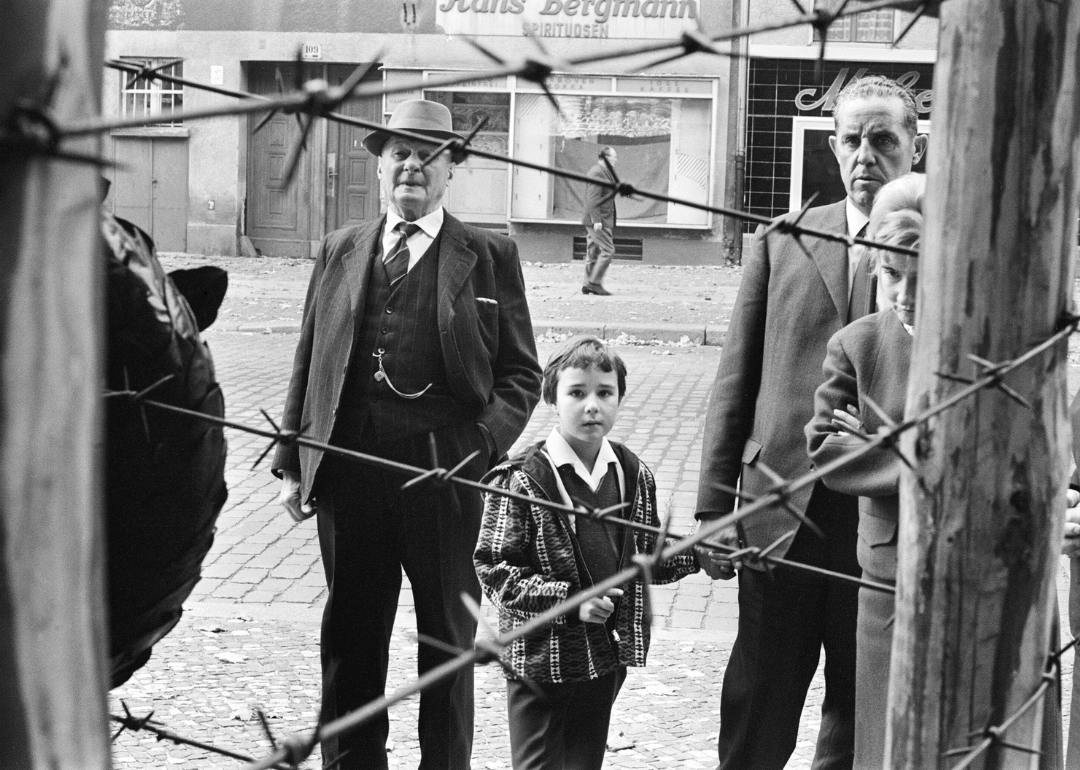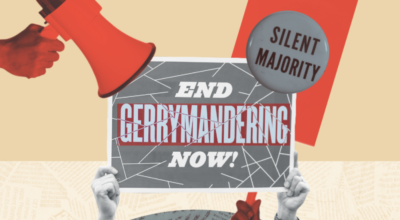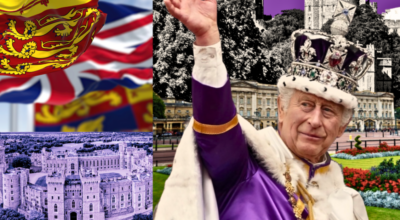A brief history of the Cold War
Published 3:00 pm Friday, April 14, 2023
Abthorp/Mirrorpix // Getty Images
A brief history of the Cold War
An estimated 56.4 million people died during World War II, making it the deadliest war of all time. Given the terrible loss of life endured by each of the warring nations, Allied and Axis alike, it is no surprise that the war’s end gave rise to tensions among the world powers when they convened to negotiate postwar terms. Soviet Premier Joseph Stalin believed the U.S.S.R.’s contributions were undermined in the resulting division of Europe, and American diplomat George Kennan, residing in Moscow, took note. In 1946, he sent the “Long Telegram” in which he detailed why he believed the Soviet Union could not peacefully coexist with capitalist countries. The telegram prompted the U.S.’s “containment” policy, an effort to prevent the spread of Soviet influence and communism in general following the war.
The U.S.S.R. responded in kind, and for the next 45 years, the two superpowers were engaged in a cycle of escalating tensions marked by the threat of the development and potential use of atomic weapons. While the U.S. and Soviet Union were technically at peace during the Cold War, the era also comprised many violent proxy wars across the globe, which both superpowers funded in a bid to expand their respective political influence. But these wars were far from the only significant events that ensued. Consulting news and historical sources, Stacker looked at some of the most important events of the Cold War, from its inception to its ultimate end.
Though the U.S.S.R. is long gone, Cold War tensions persist in modern geopolitics. Both the U.S. and Russian Federation maintain geographic strongholds and substantive defense budgets. Most recently, the Russian invasion of Ukraine in early 2022 has prompted concerns of a blossoming new Cold War.
You may also like: Major civil rights moments in every state
![]()
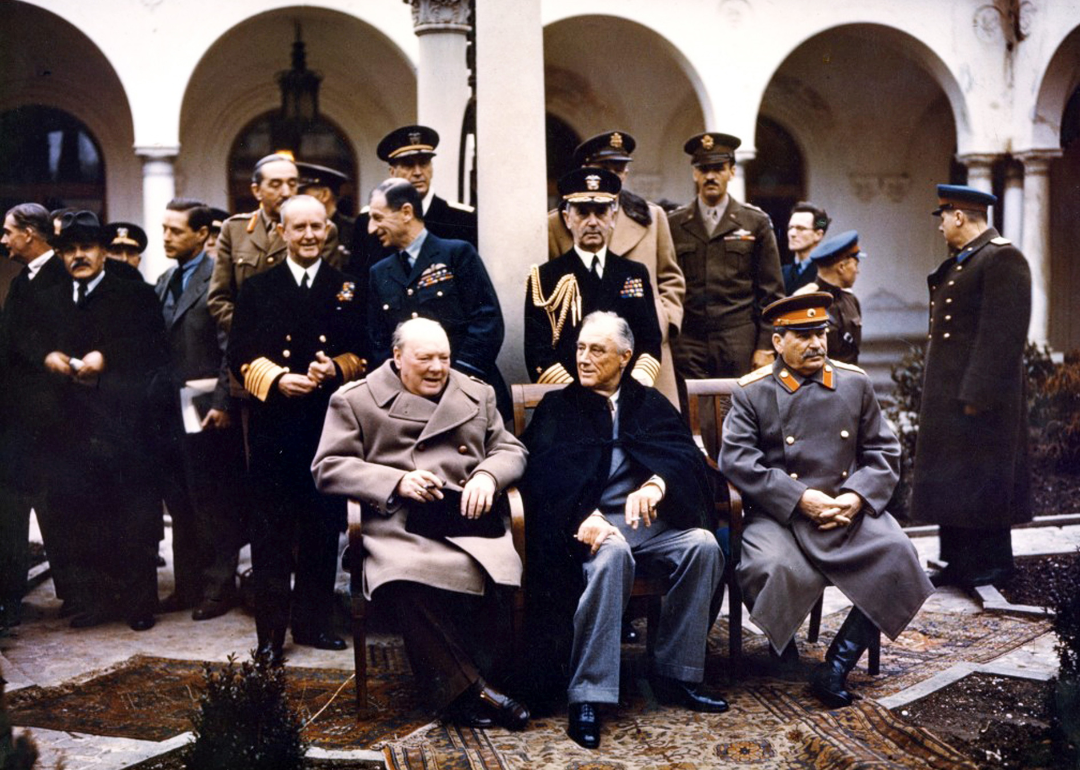
Pictures from History/Universal Images Group via Getty Images
1945: Conferences at Yalta and Potsdam
On Feb. 4, 1945, President Franklin D. Roosevelt, Prime Minister Winston Churchill, and Soviet Premier Joseph Stalin convened in the resort town of Yalta on the Crimean Peninsula to discuss diplomatic concerns in anticipation of the end of World War II. Over the course of eight days, with Allied victory in Europe all but assured, the leaders attempted to craft a new vision for Europe’s future, one that would include the postwar governing of Germany and the process of holding that nation accountable for reparations.
The Allied leaders met again—with President Truman in place of the recently passed Roosevelt, who died less than a month before, and Prime Minister Clement Attlee replacing Churchill midway through talks, after Britain’s July elections—in Potsdam following Germany’s surrender on May 8, 1945, to continue to negotiate that country’s reorganization. While the world powers got along famously well during Yalta, competing interests reared their heads over the two weeks in Potsdam, prompting tension among the countries and foreshadowing the dissolution of the alliance and the beginning of the Cold War.
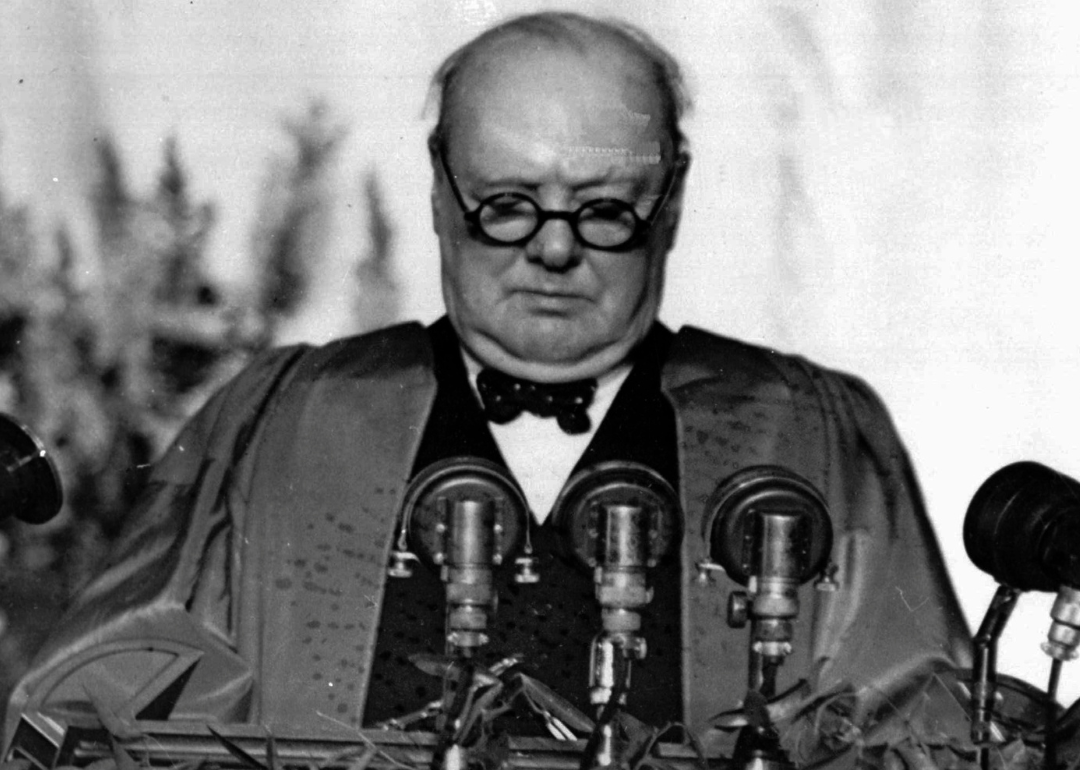
PA Images via Getty Images
1946: Churchill’s “Iron Curtain” speech
On March 5, 1946, Prime Minister Winston Churchill formally alerted the world to the growing postwar influence of the Soviet Union and communism during his “Sinews of Peace” speech at Westminster College in Fulton, Missouri. Churchill had been personally invited by President Truman, who hailed from Missouri. He famously used the term “iron curtain” to describe the divide between communist and noncommunist regions in Europe and emphasized the importance of maintaining a strong American-British alliance in opposition to the Soviet sphere of influence.
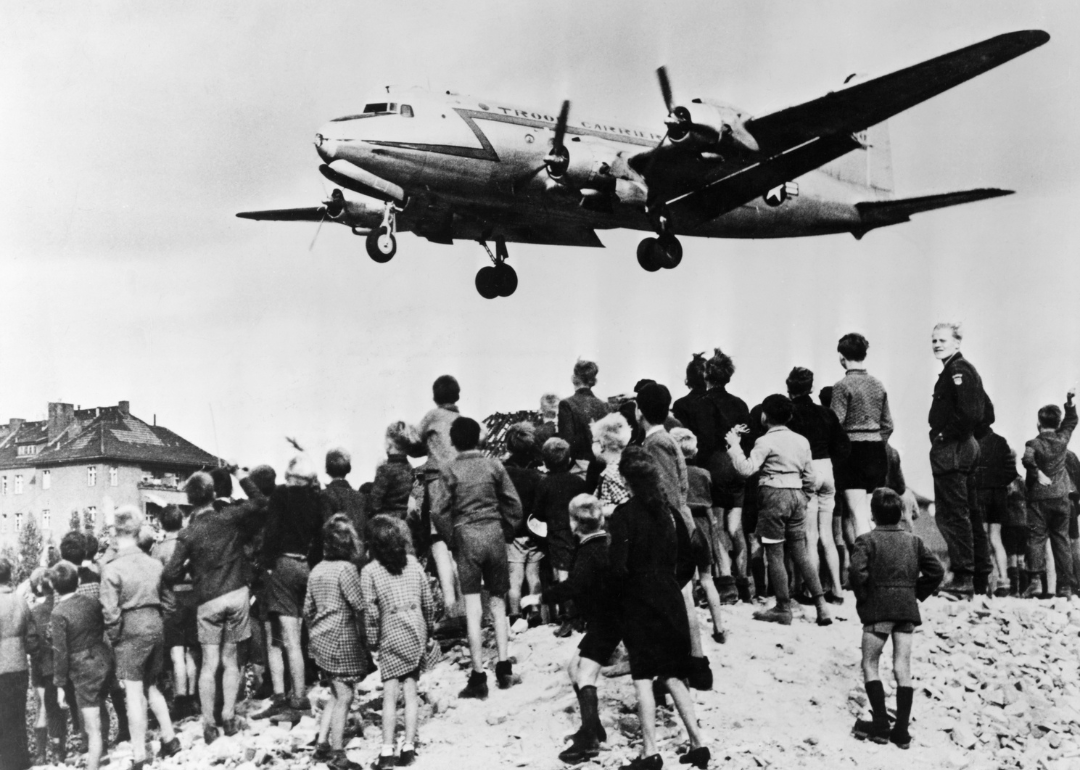
Bettmann // Getty Images
1948-1949: Berlin Blockade
After the U.S., U.K., and France merged their respective postwar occupation zones of Germany to create West Germany, the Soviet Union responded by blocking access to all roads, canals, and railroads that led to Allied-controlled Berlin. Over 2 million citizens were left without access to food, medicine, and fuel during the 11-month blockade, leading Western powers to initiate the Berlin Airlift. This mission saw the combined efforts of the Allied countries deliver critical aid by airdrops for nearly a year—at one point, planes were landing in West Berlin every 45 seconds—until the U.S.S.R. lifted the blockade on May 11, 1949. The airlift continued until September 1949, a hedge against Soviet reversal, before coming to a close.
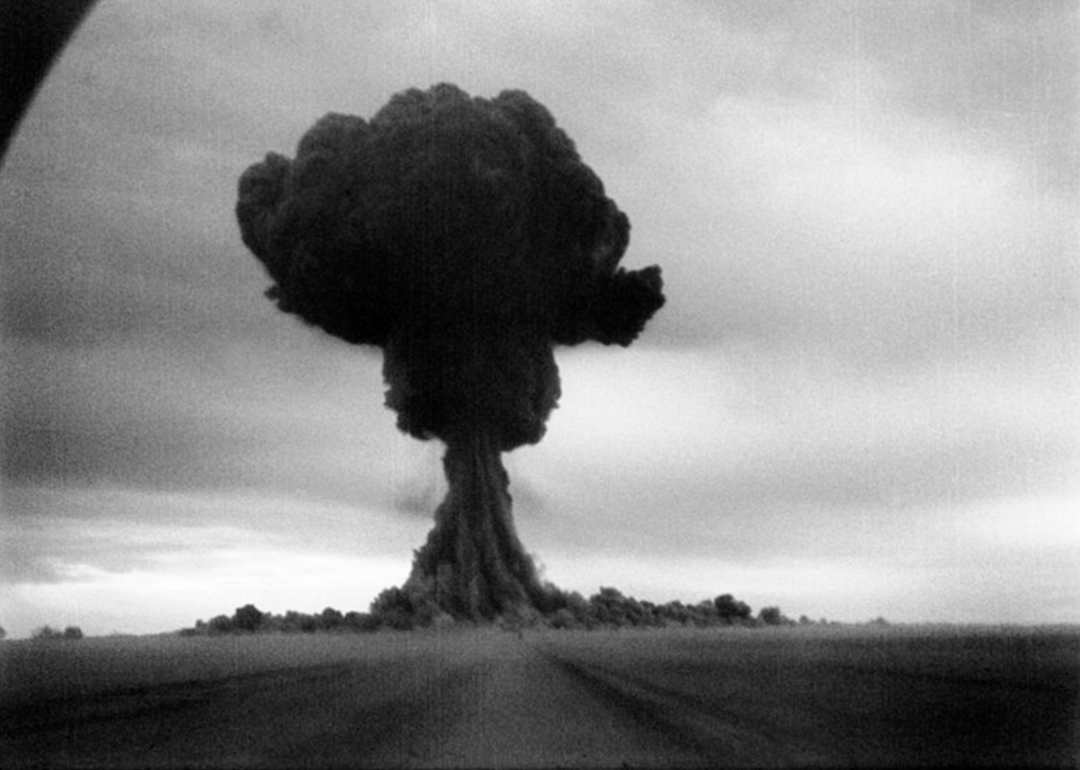
Sovfoto/Universal Images Group via Getty Images
1949: Russia tests its first atomic bomb; NATO ratified
On Aug. 29, 1949, Russia detonated its first atomic bomb at the Kazakhstan-based Semipalatinsk test site. The development escalated tensions in the arms race between the U.S. and the Soviet Union. Meanwhile, the U.S. and 11 other countries signed the North Atlantic Treaty Organization agreement, which formalized a defensive alliance of nations against Soviet aggression.
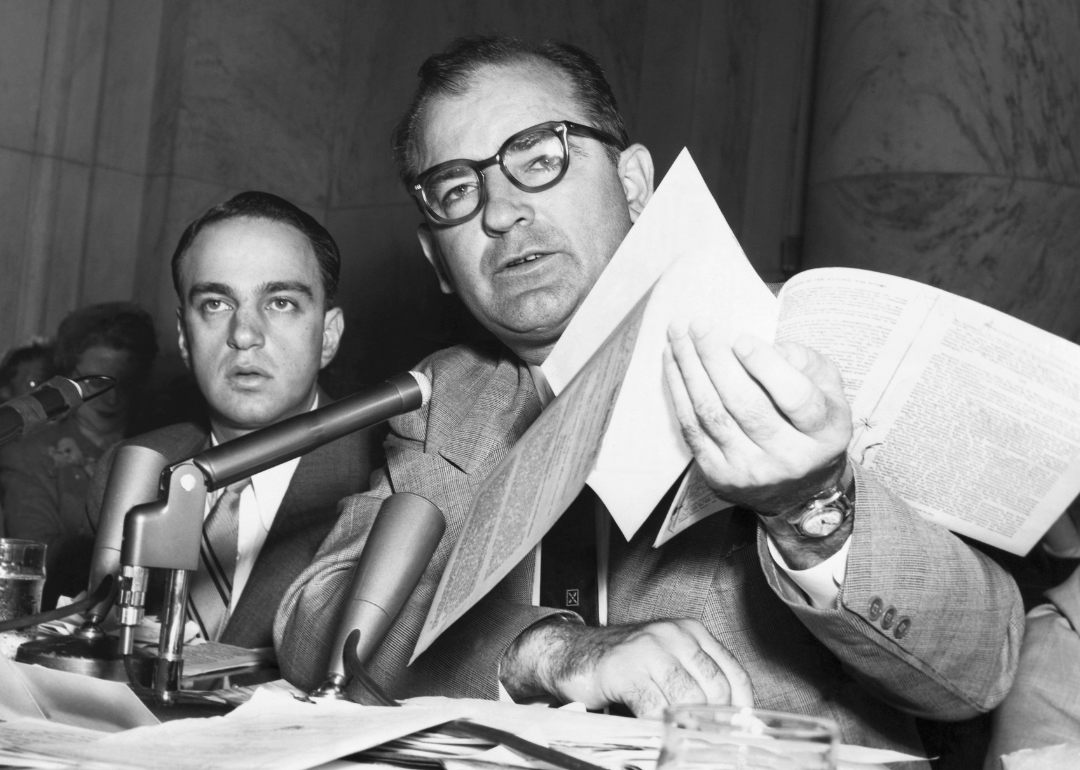
Bettmann // Getty Images
1950s: The “Red Scare” allows rise of McCarthyism
As tensions rose between the U.S. and the Soviet Union, Americans began to fear that Communists had infiltrated the government. Wisconsin Senator Joe McCarthy fueled the growing paranoia by claiming he had a list of high-profile defectors feigning loyalty to the U.S. but carrying out espionage activities on behalf of the U.S.S.R. McCarthy’s aggressive tactics caused many figures to lose their jobs and reputations—notably several hundred artists, writers, and actors, as McCarthyism zeroed in on Hollywood as a bastion of supposed Communist activity. Eventually, McCarthy’s methods led to his own downfall when he was censured by the Senate in 1954.
You may also like: Iconic buildings that were demolished
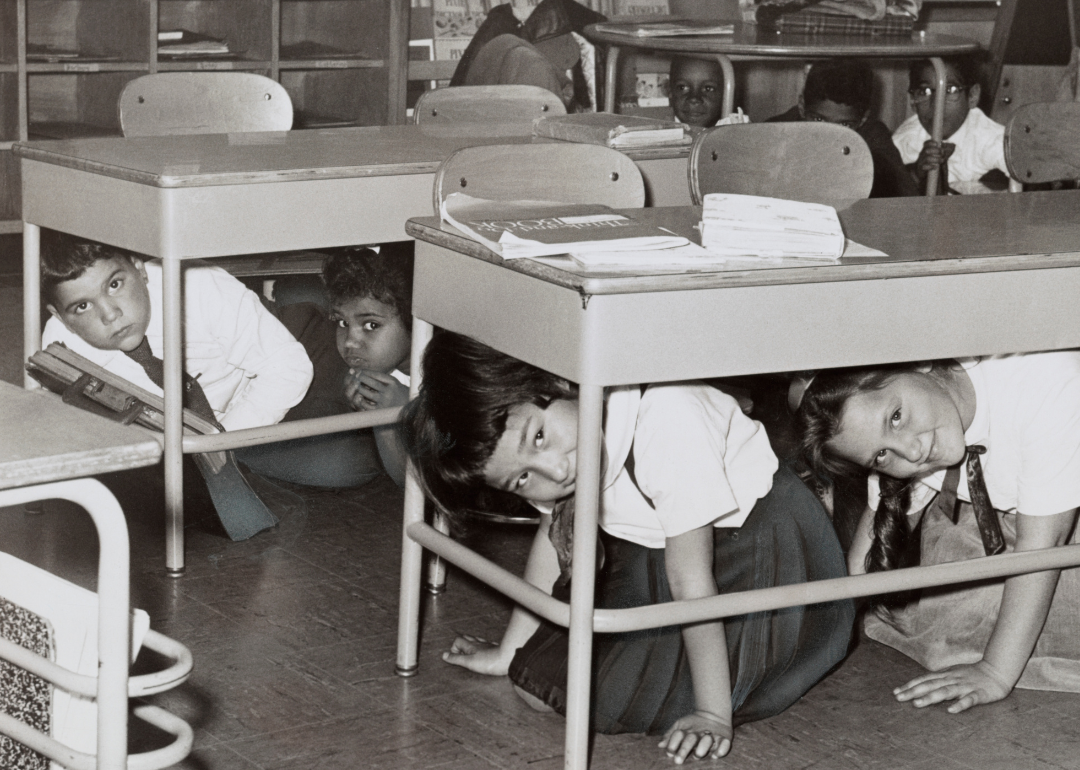
GraphicaArtis // Getty Images
1952: Duck and Cover PSA distributed across the US
The Soviet Union’s successful atomic bomb test in 1949 increased the plausibility of a nuclear war. In response to the growing threat, U.S. authorities created a video to educate Americans about how to protect themselves in the event of a nuclear explosion. The dystopian film features Bert the Turtle who protects himself from a monkey holding a firecracker by ducking into his shell. Afterward, a narrator explains that ducking and covering immediately after seeing an atomic bomb flash offers the best chance for survival.
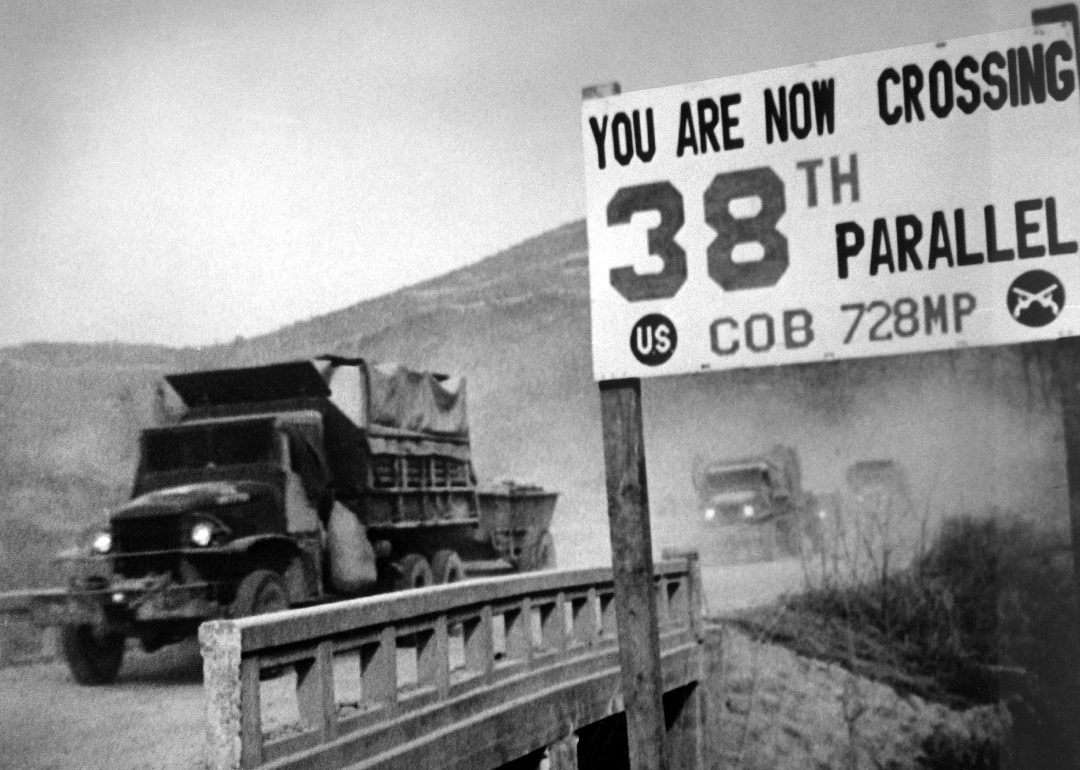
Interim Archives // Getty Images
1950-1953: Korean War serves as a shadow conflict between the U.S. and Russia
On June 25, 1950, North Korean soldiers allied with China and its Communist government instigated the first military action of the Cold War when they crossed over the 38th parallel to invade South Korea. Within days, the U.S. joined forces with South Korea in an effort to halt the perceived spread of communism. The war ended on July 27, 1953, when China, North Korea, South Korea, and the U.S. agreed to an armistice, leaving Korea bifurcated into two regions just as it was before the war.
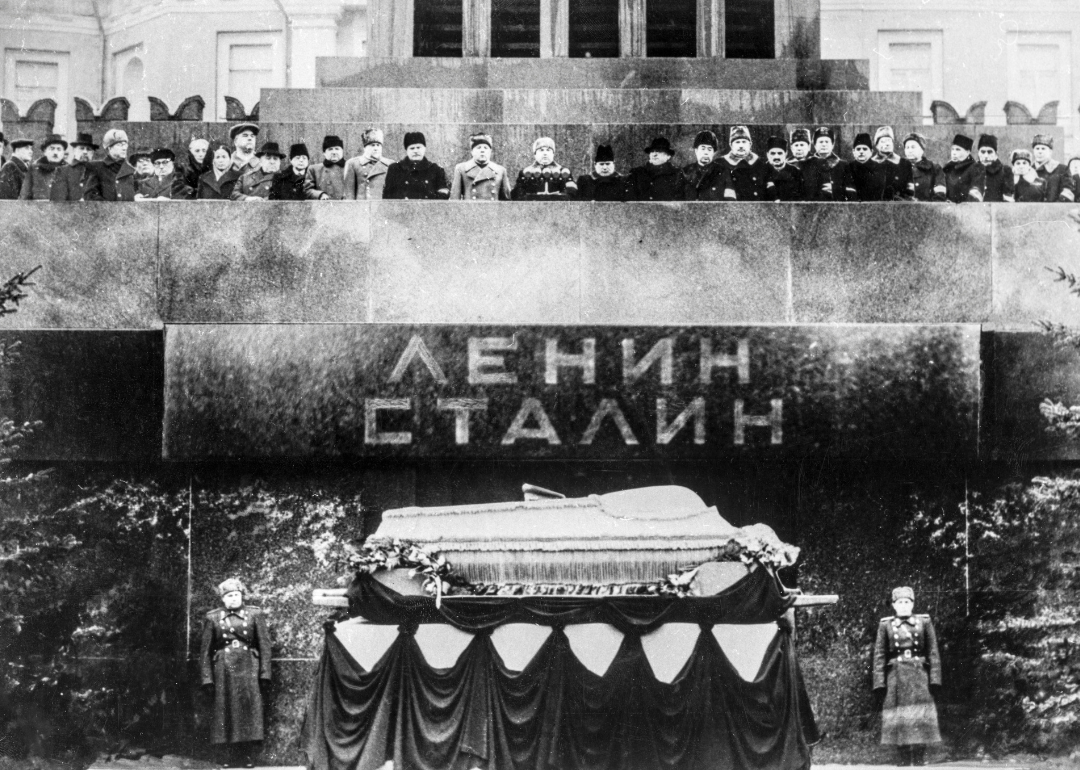
API/Gamma-Rapho via Getty Images
1953: Joseph Stalin dies, leaving a power vacuum
On March 5, 1953, Soviet leader Joseph Stalin died from a stroke. He failed to name a successor before his death, leaving three figures to compete for the role. Nikita Khrushchev emerged victorious in 1956. Khrushchev publicly denounced Stalin’s reign during his “Secret Speech” and promoted “de-Stalinization” as a core feature of his domestic policy.
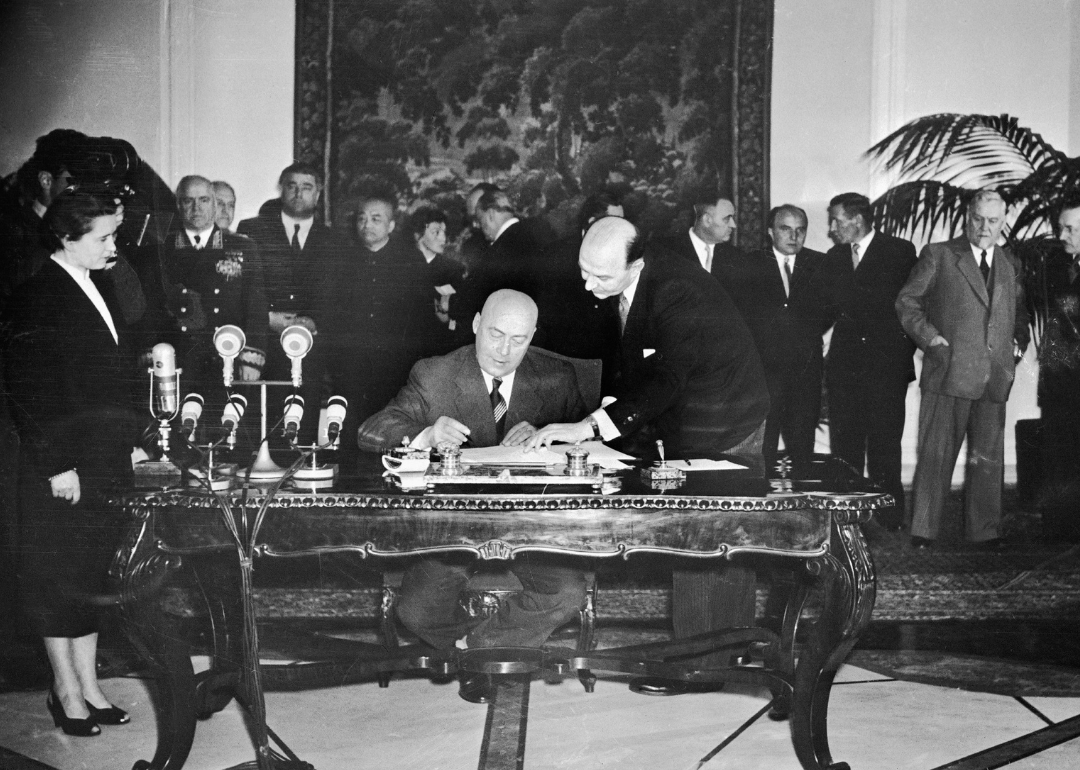
Keystone-France/Gamma-Keystone via Getty Images
1955: Warsaw Pact formed
On May 14, 1955, the Soviet Union, Albania, Poland, Romania, Hungary, East Germany, Czechoslovakia, and Bulgaria agreed to form a military alliance known as the Warsaw Treaty Organization or Warsaw Pact. The alliance was formed in direct response to the Allies’ creation of NATO and the subsequent decision to remilitarize West Germany.
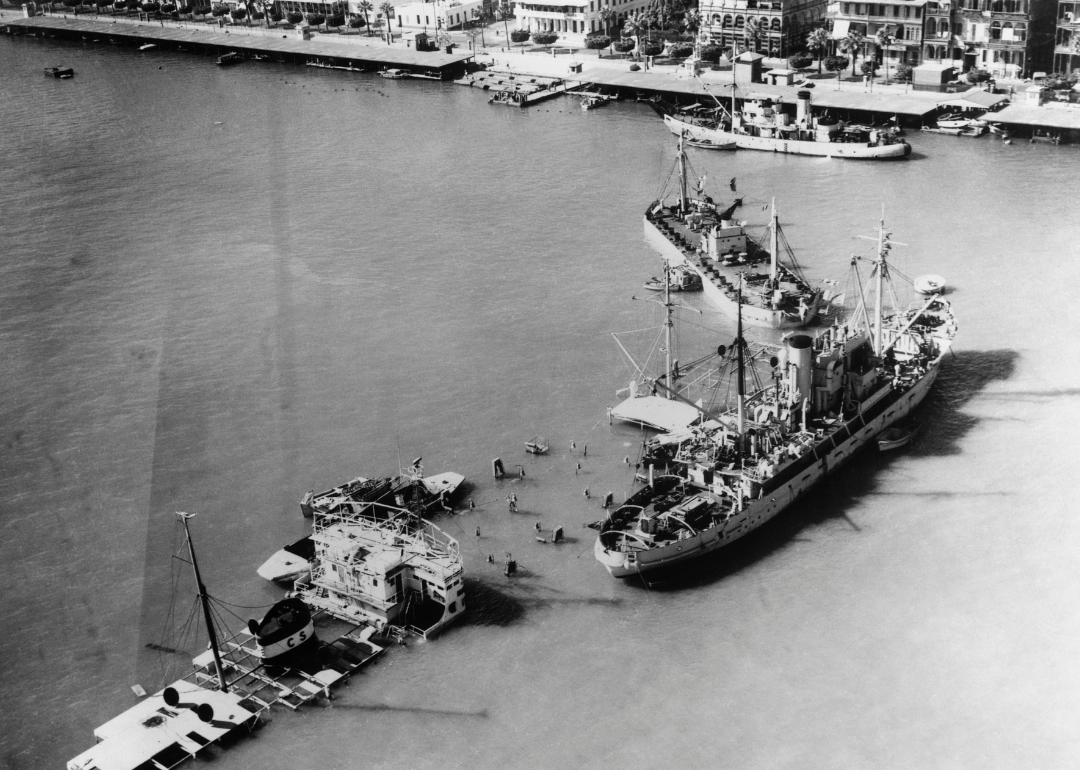
Hulton-Deutsch/Hulton-Deutsch Collection/Corbis via Getty Images
1956: Twin crises unfold in Hungary and Suez Canal
In response to Egypt’s growing closeness with the Soviet Union, the U.S., and Britain refused to finance upgrades to the commercially owned Suez Canal. Egyptian President Gamal Abdel Nasser nationalized the canal in response, sparking an international crisis over possible trade disruptions and influence in the Middle East. Meanwhile, Hungarian citizens instigated a revolution against the Hungarian People’s Republic in reaction to a speech by Nikita Khrushchev denouncing Stalin’s reign that ultimately set the stage for autonomous rule in Hungary.
You may also like: What the 50 biggest cities in America looked like 50 years ago
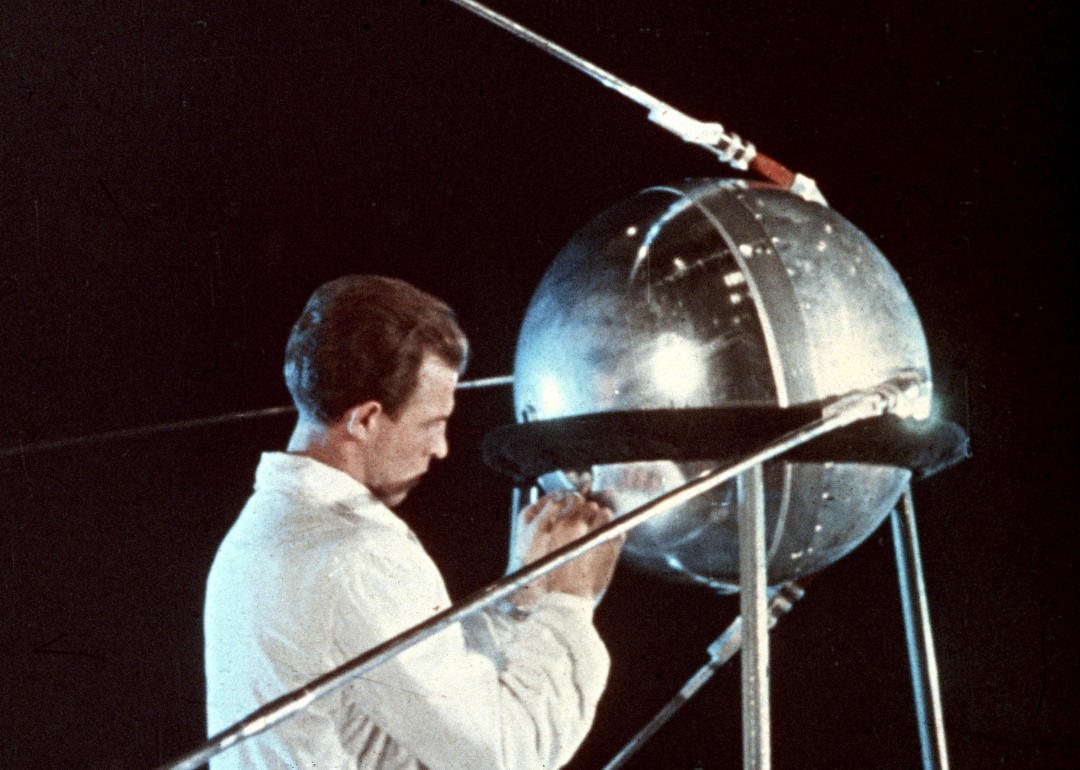
Sovfoto/Universal Images Group via Getty Images
1957: Russia launches Sputnik and Sputnik II into space (US loses space race)
On Oct. 4, 1957, the Soviet Union space program successfully launched the first artificial Earth satellite, Sputnik, into low Earth orbit. Even though Sputnik was just roughly the size of a beach ball, the event marked an ideological victory for the Soviet Union against the U.S. in the space race. That triumph was cemented by the subsequent launching of Sputnik II a month later, which was the first to carry an animal into orbit—Laika, a stray mixed-breed dog.
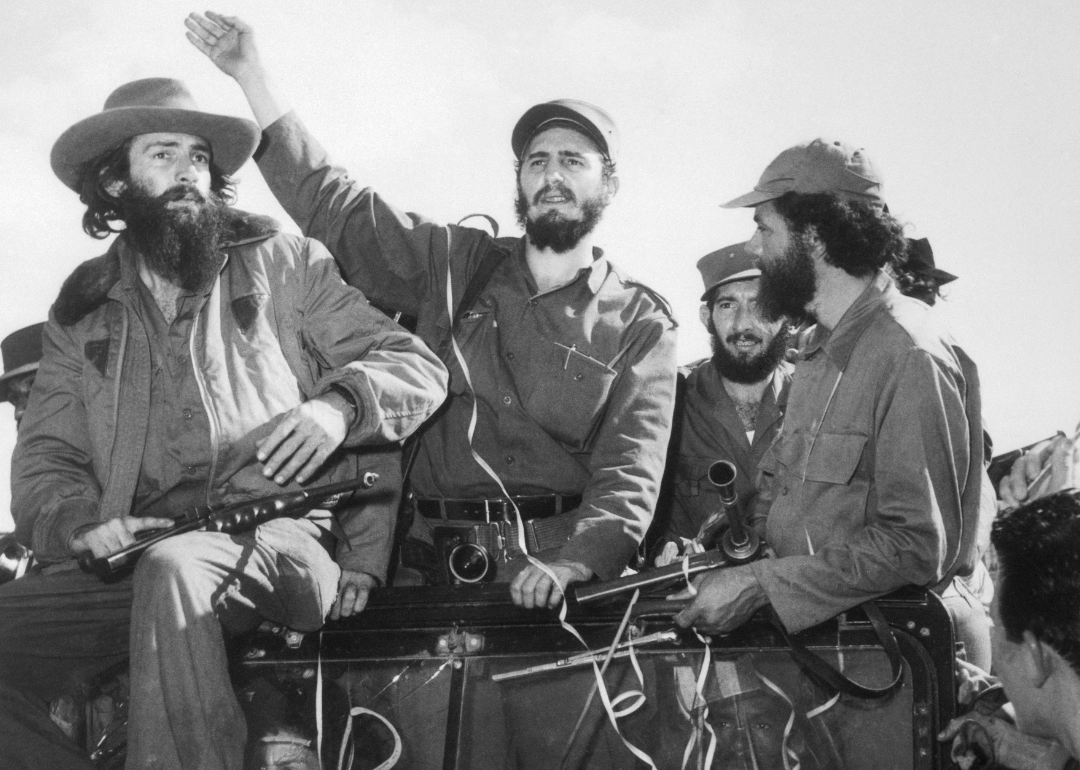
Bettmann // Getty Images
1959: Cuban Revolution
On Jan. 1, 1959, a rebel army of Communist sympathizers, led by Fidel Castro, officially defeated the Cuban army after fighting for over five years following the 1952 Cuban coup d’état, which placed Fulgencio Batista at the helm of the Cuban government. The revolution ousted Bastista and ushered in a new era of rule with Castro as head of state and the subsequent deterioration of relations between Cuba and the U.S.
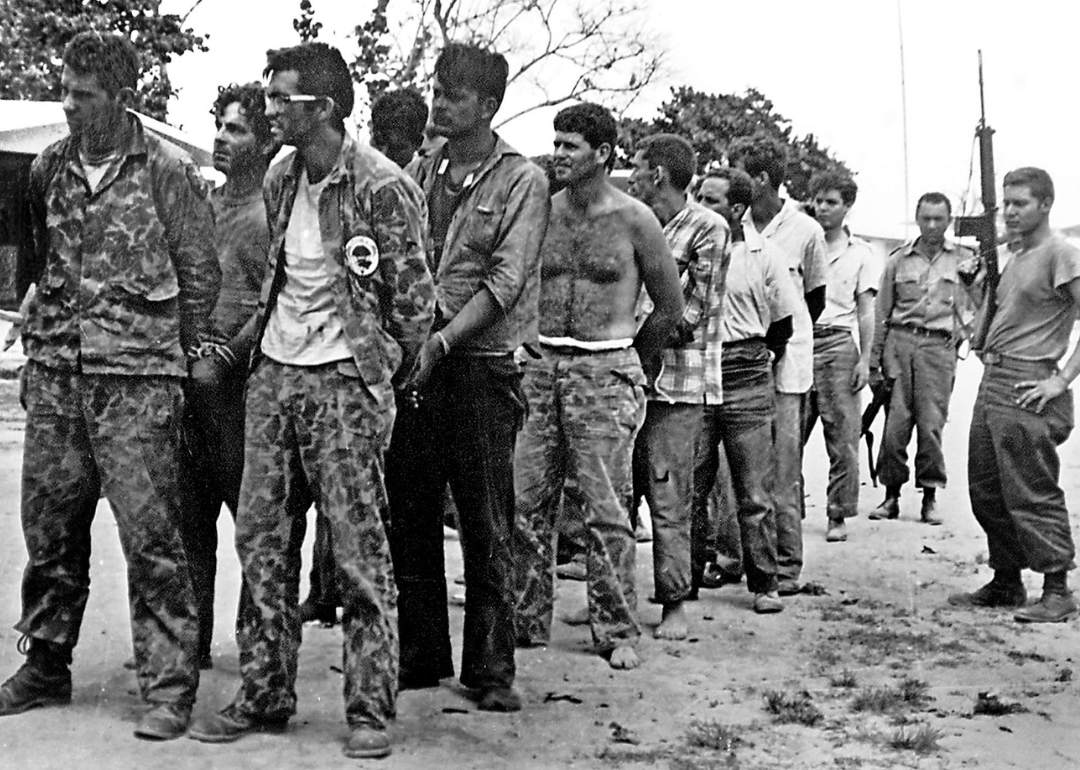
MIGUEL VINAS/AFP via Getty Images
1961: Bay of Pigs invasion; construction of Berlin Wall begins
On April 17, 1961, Cuban exiles, accompanied by the U.S. military, attempted to breach the Cuban shoreline in an unsuccessful attempt to overthrow Castro’s newly established government. The American-funded effort was a colossal failure and prompted stronger allyship between Cuba and the Soviet Union. Later that year, in August, a barbed wire fence was erected by East German authorities, separating West Berlin from the remainder of the city. Concrete placements soon followed, and within two weeks West Berlin was completely isolated.
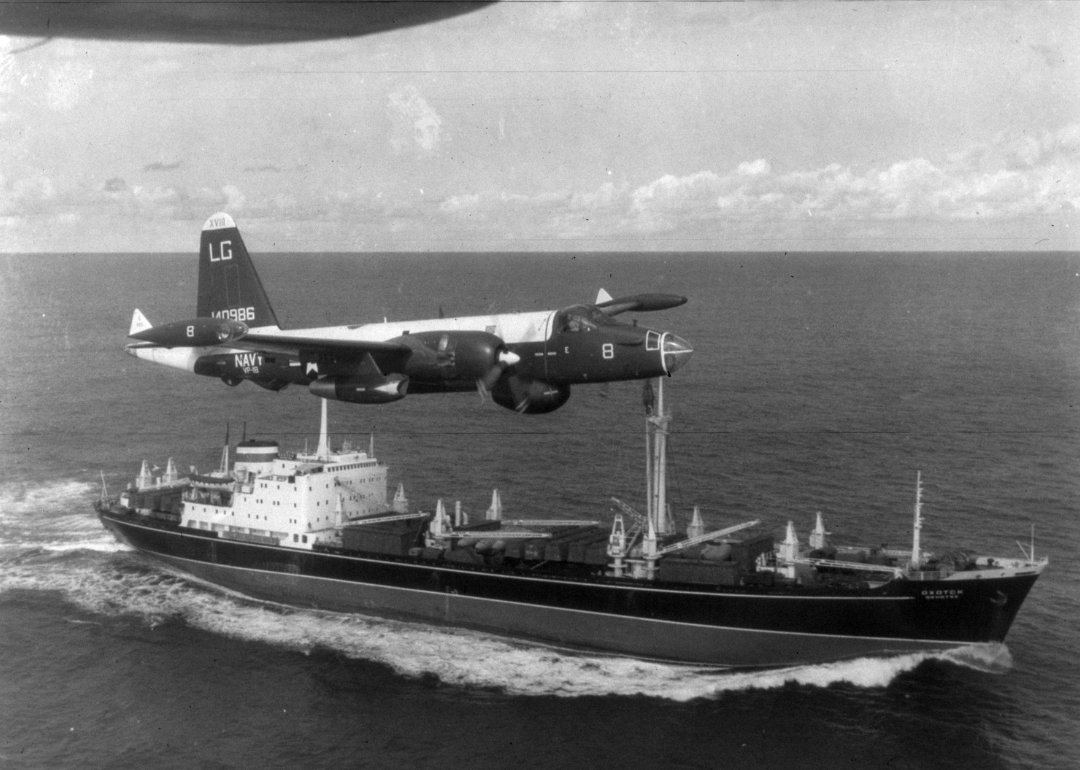
Getty Images
1962: The “Thirteen Days”
As American and Soviet Union nuclear capabilities progressed, so too did tensions between the U.S. and Cuba, which had, so far as American political interests were concerned, become a Communist stronghold following Fidel Castro’s defeat of the U.S.-backed Batista regime. When the Soviet Union installed nuclear missiles on the shoreline of Cuba, approximately 90 miles from the U.S., President Kennedy ordered a naval blockade of Cuba to keep the Soviets from bringing any further supplies or personnel to the island. The two superpowers finally took a mutual step back from the brink of nuclear war on Oct. 26, 1962, after Khrushchev agreed to remove the missiles and Kennedy agreed not to invade Cuba.
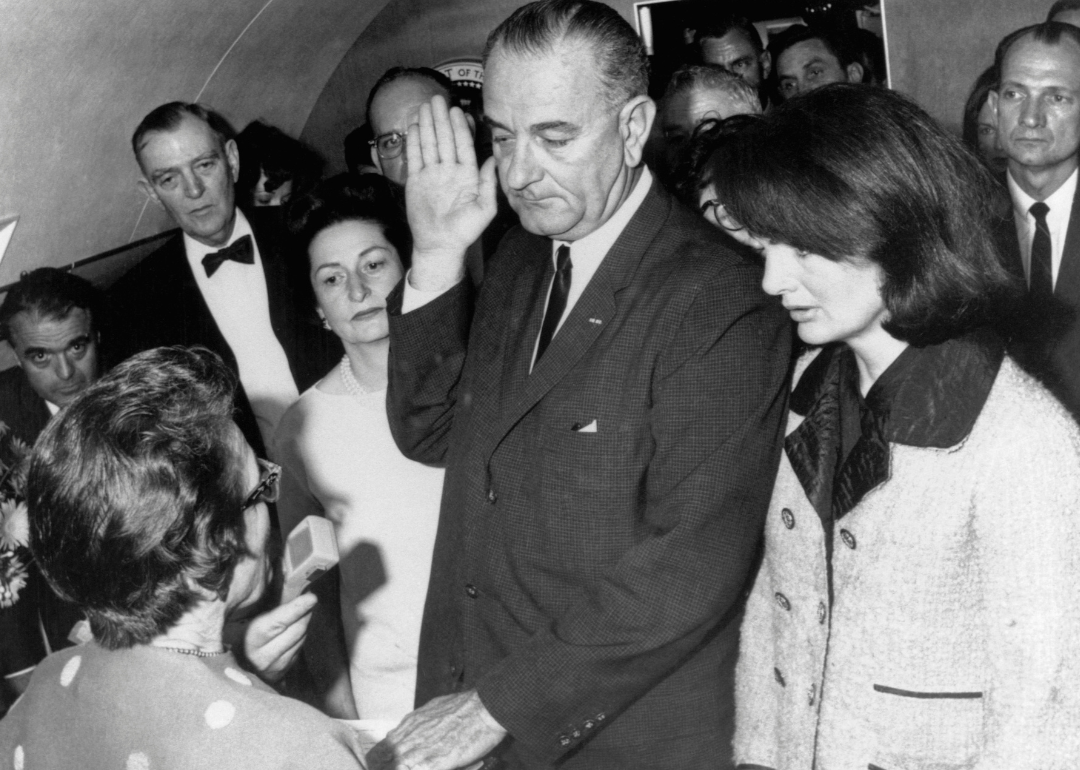
Bettmann/CORBIS/Bettmann Archive // Getty Images
1963: JFK assassinated in Dallas, Texas
On Nov. 22, 1963, President John F. Kennedy was assassinated by Lee Harvey Oswald in Dallas, Texas. While myriad conspiracy theories have been floated in the wake of Kennedy’s death, the official report of the incident points to Oswald as the lone assassin. Lyndon B. Johnson assumed the presidency immediately after Kennedy’s death, beginning a more aggressive approach to international relations.
You may also like: Major newspaper headlines from the year you were born
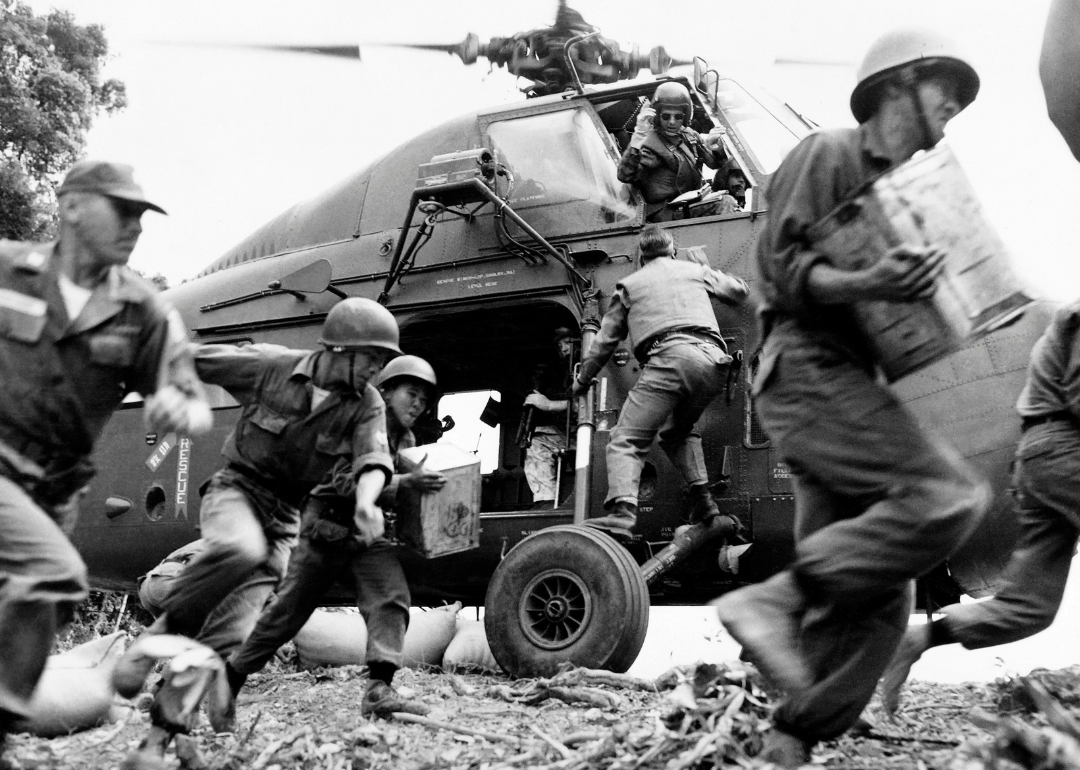
AFP via Getty Images
1964: Gulf of Tonkin incident brings US directly into Vietnam
When Vietnamese torpedo boats attacked two American destroyers unprompted, Congress passed the Gulf of Tonkin resolution, permitting the U.S. to retaliate against Vietnam in the interest of maintaining world peace. This resolution in effect gave President Lyndon Johnson carte blanche authority to amplify American military activities in Vietnam, which he did in early 1965.
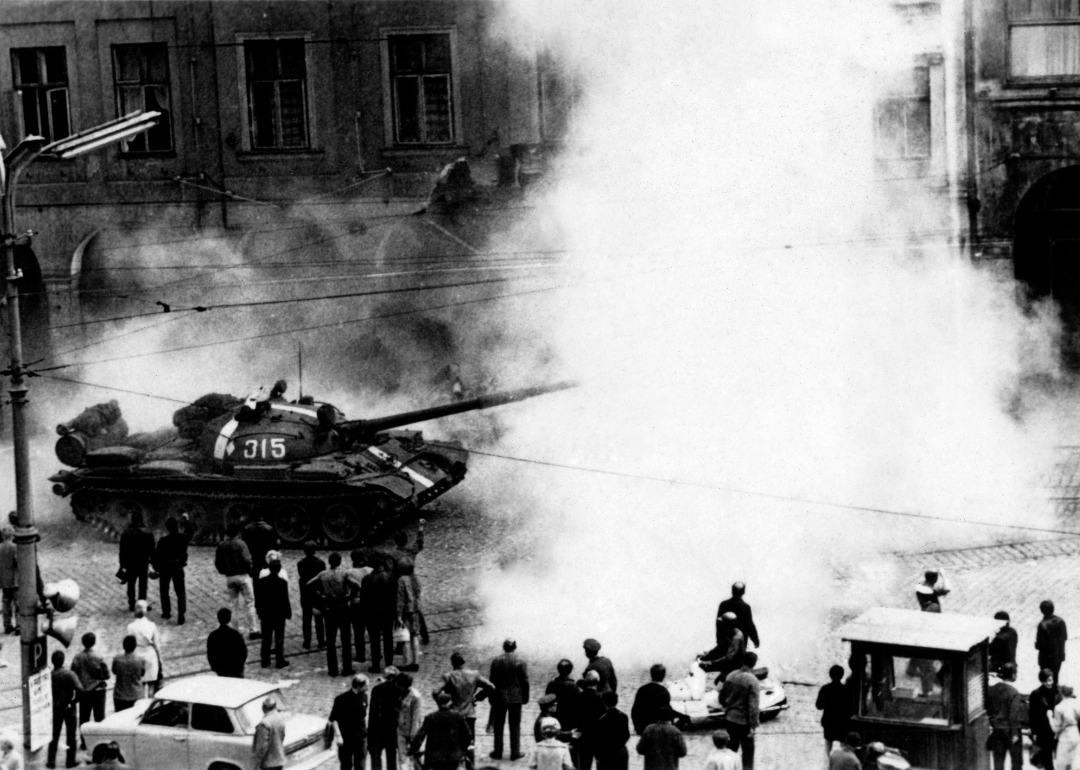
Helmut Hoffmann/ullstein bild via Getty Images
1968: USSR invades Czechoslovakia amid Prague Spring
When Alexander Dubcek succeeded Communist ruler Antonin Novotny, he began implementing liberal policies to the short-lived relief of Czechoslovakians and the ire of the country’s Communist allies. On Aug. 20, 1968, after seven months of the new rule, the U.S.S.R. invaded the country, repealed Dubcek’s reforms, and replaced him with pro-Soviet Gustav Husak.
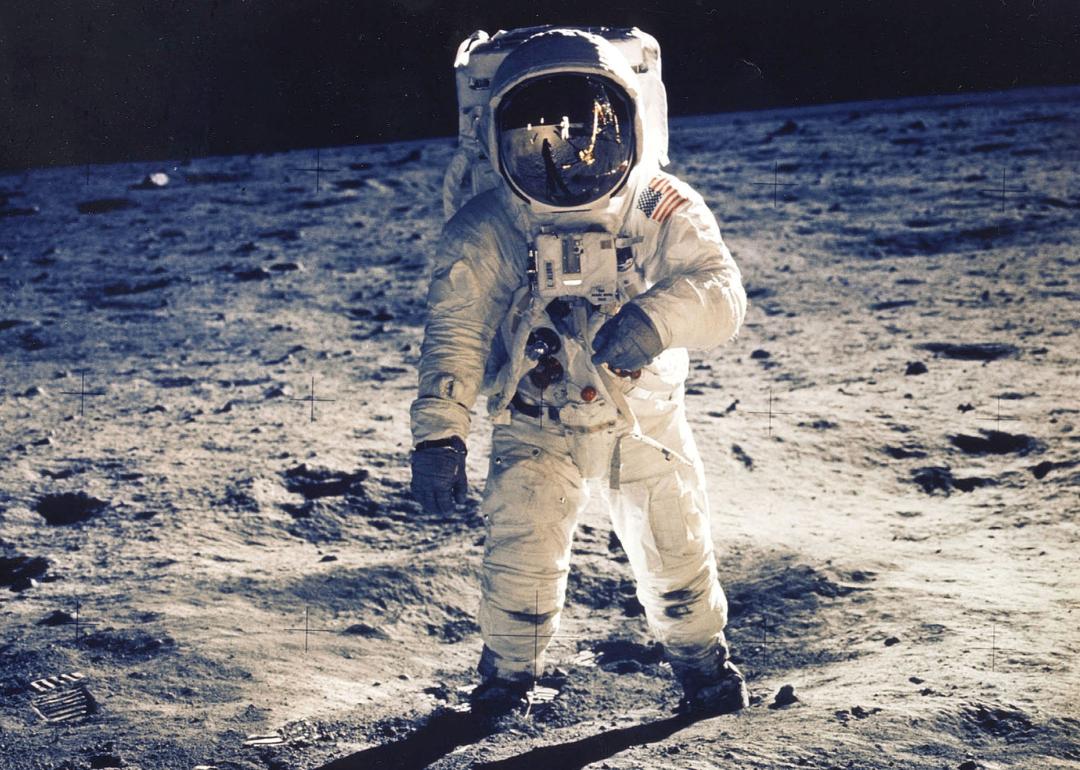
NASA // Getty Images
1969: Apollo 11 lands on the moon (US wins moon race)
The U.S. made history on July 20, 1969, when it successfully landed spaceflight Apollo 11 on the moon, after which astronauts Neil Armstrong and Buzz Aldrin walked on its surface in a first for mankind. The excursion was an ideological victory for the United States in the moon race against the Soviet Union.
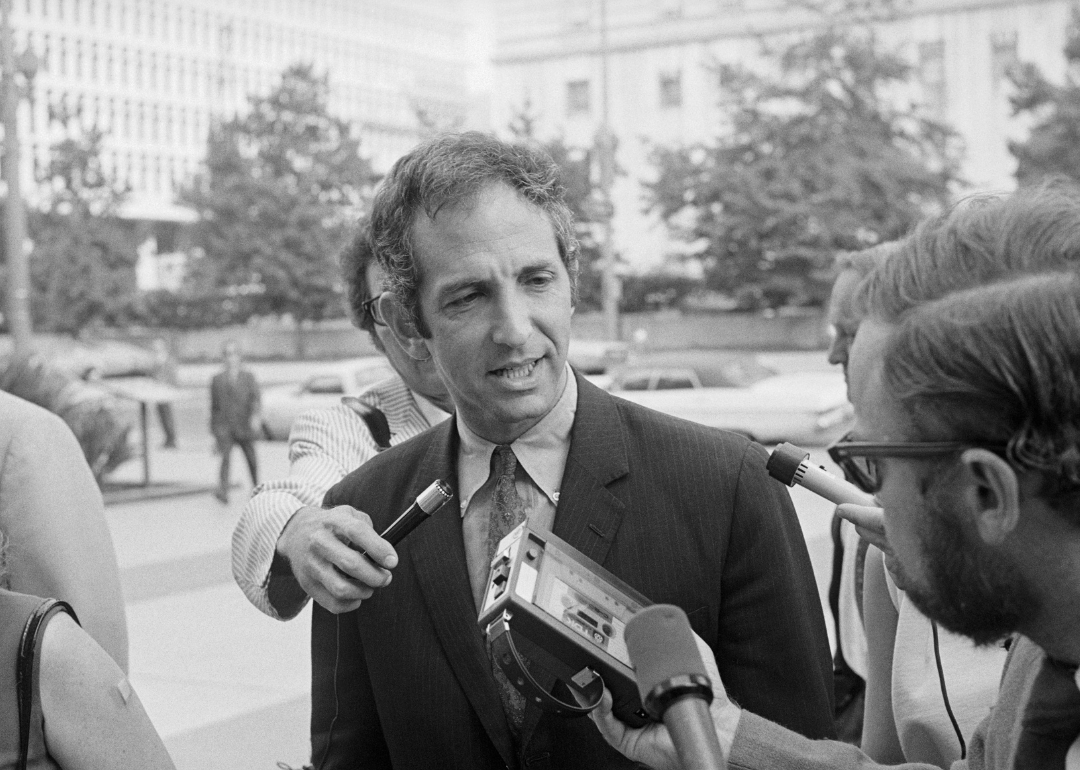
Bettmann // Getty Images
1971: Publication of the Pentagon Papers exposes US military involvement in Vietnam since 1945
In March 1971, military analyst Daniel Ellsberg sent a copy of a study to the New York Times revealing U.S. military and political involvement in Vietnam since 1945. Despite attempted injunctions against the publication of the study, the series of articles that resulted, in both the Times and Washington Post, from the leak undermined Americans’ trust in the government, particularly concerning the deeply unpopular Vietnam War and its apparent rapid escalation.
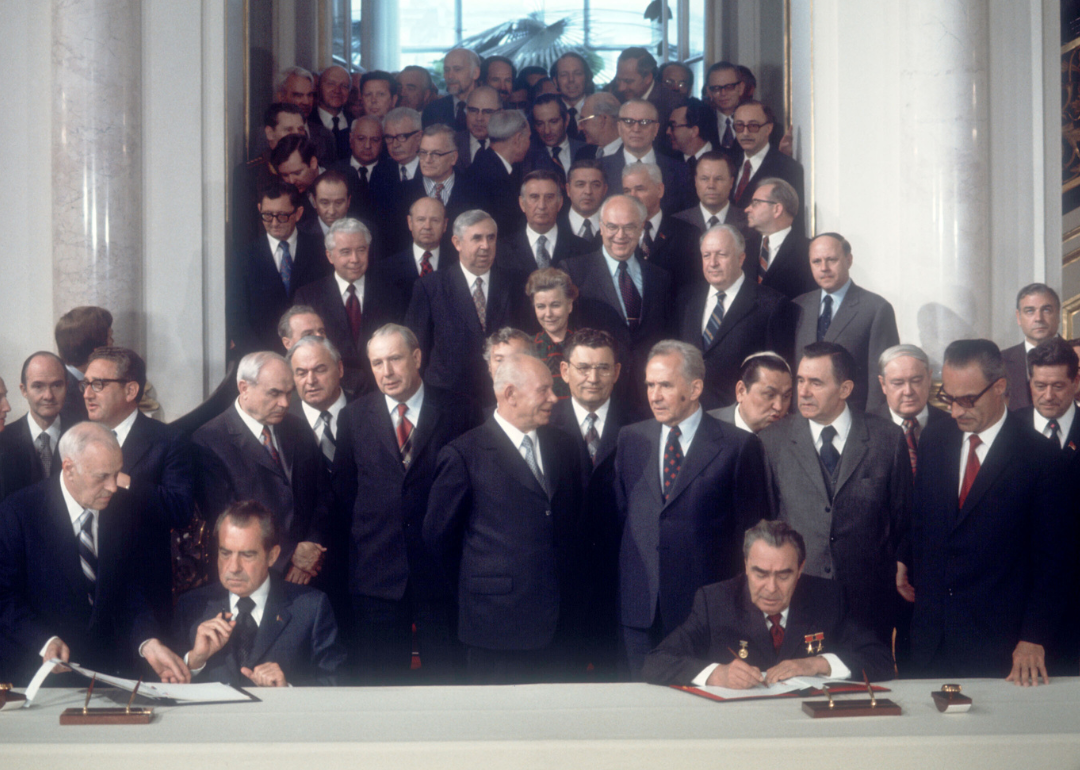
Dirck Halstead/Liaison // Getty Images
1972: SALT I treaty signed between US and Soviet Union
On May 26, 1972, the U.S. and Soviet Union formally agreed to the first of two Strategic Arms Limitation Talks, commonly known as SALT. The legislation aimed to initiate the de-escalation of the arms race, focusing specifically on reducing the number of nuclear missiles in each country’s arsenal.
You may also like: Evolution of road safety standards
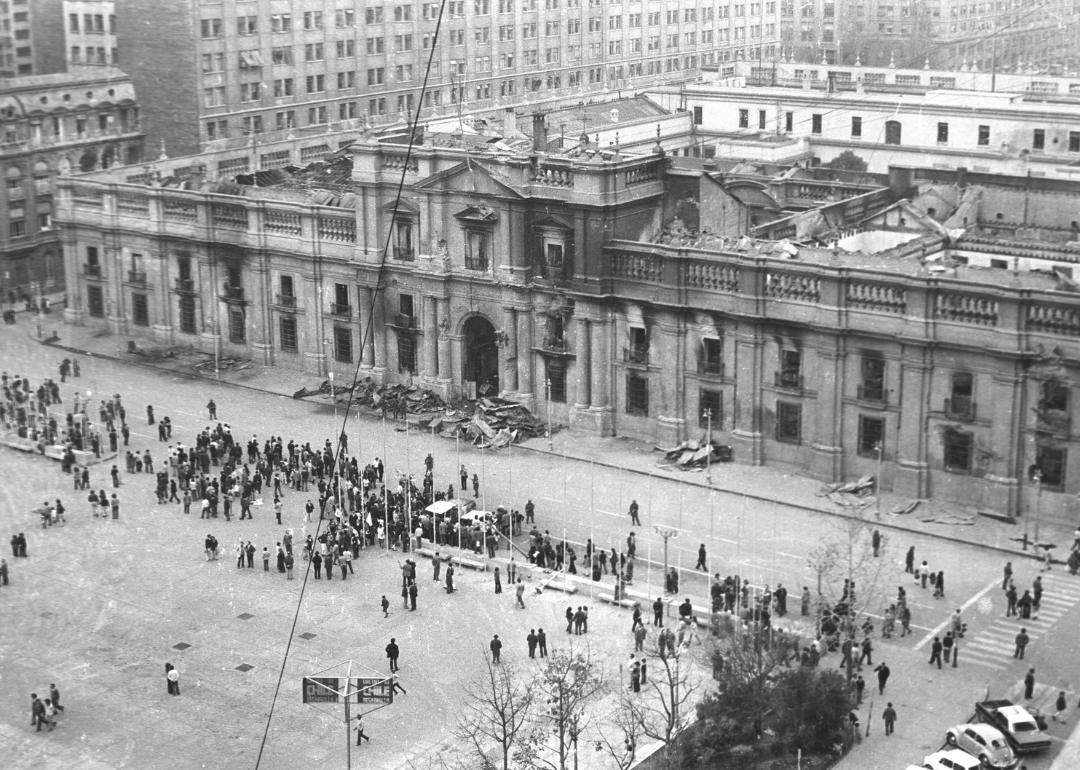
Horacio Villalobos/Corbis via Getty Images
1973: Last US combat troops leave Vietnam; US-supported coup in Chile establishes dictatorship
On March 29, 1973, the last U.S. troops left South Vietnam, signifying the end of American involvement in the country. Meanwhile, the CIA, under President Nixon’s direction, began providing support to various Chilean resistance groups after the country elected socialist Salvador Allende as president. One coup attempt successfully ousted Allende and replaced him with Augusto Pinochet as dictator.
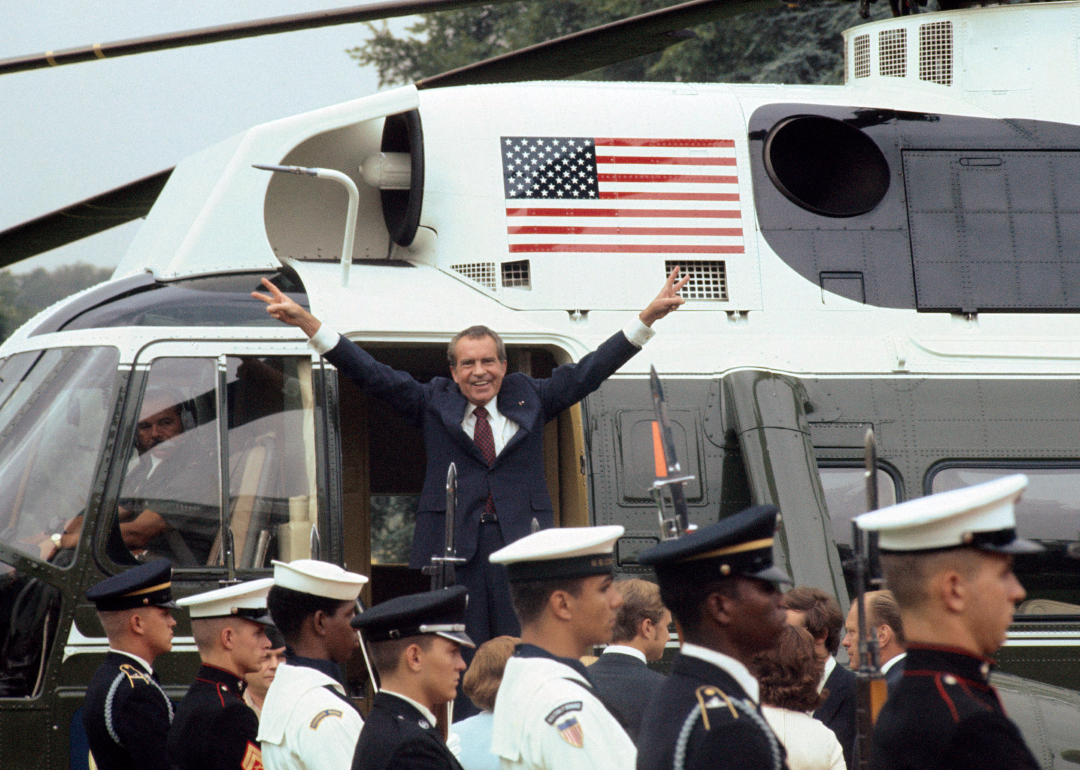
Bettmann // Getty Images
1974: Nixon resigns presidency
On Aug. 9, 1974, Richard Nixon became the first president in American history to resign from office. Presumably, Nixon succumbed to an anticipated impeachment for his involvement in the Watergate scandal. The former president famously ended his tenure waving two peace signs as he boarded a helicopter.
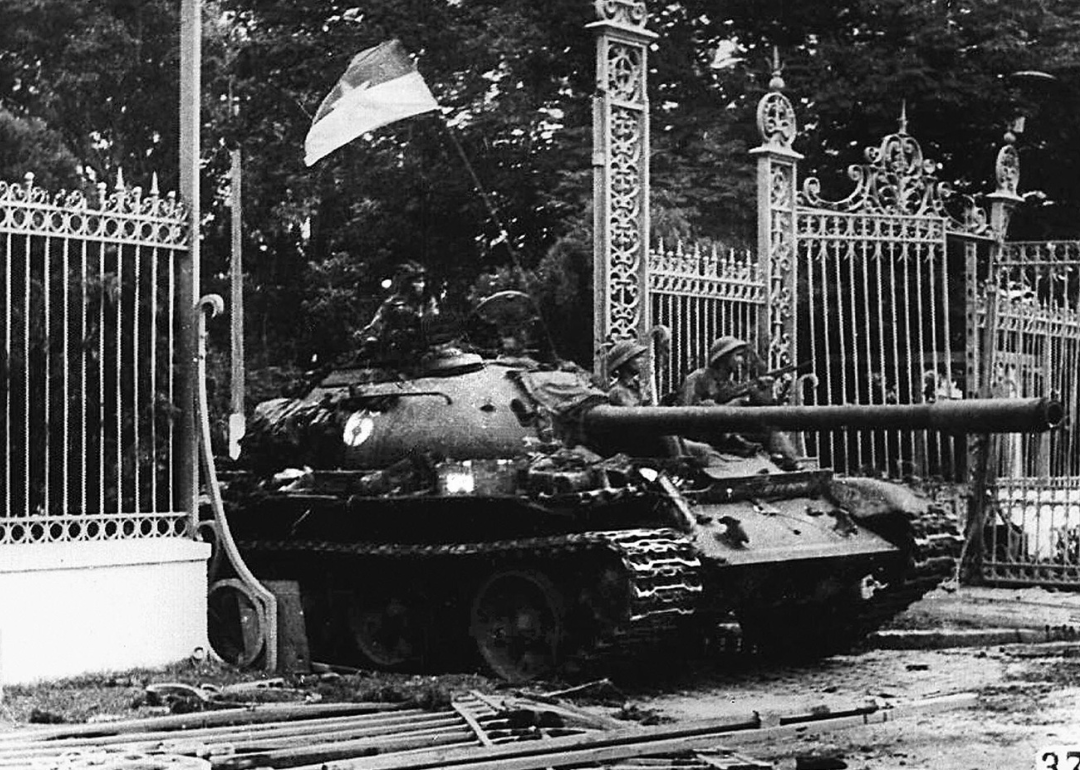
AFP via Getty Images
1975: South Vietnam falls to Communist forces
While the Vietnam War formally concluded in 1973, tensions persisted between the North and South. The U.S., distracted by Watergate and Nixon’s resignation, was unable to provide support to South Vietnam as the North rapidly advanced. On April 30, 1975, Saigon fell to North Vietnamese forces, ending the war. Saigon was swiftly renamed Ho Chi Minh City, after the revolutionary leader who led the North to victory.
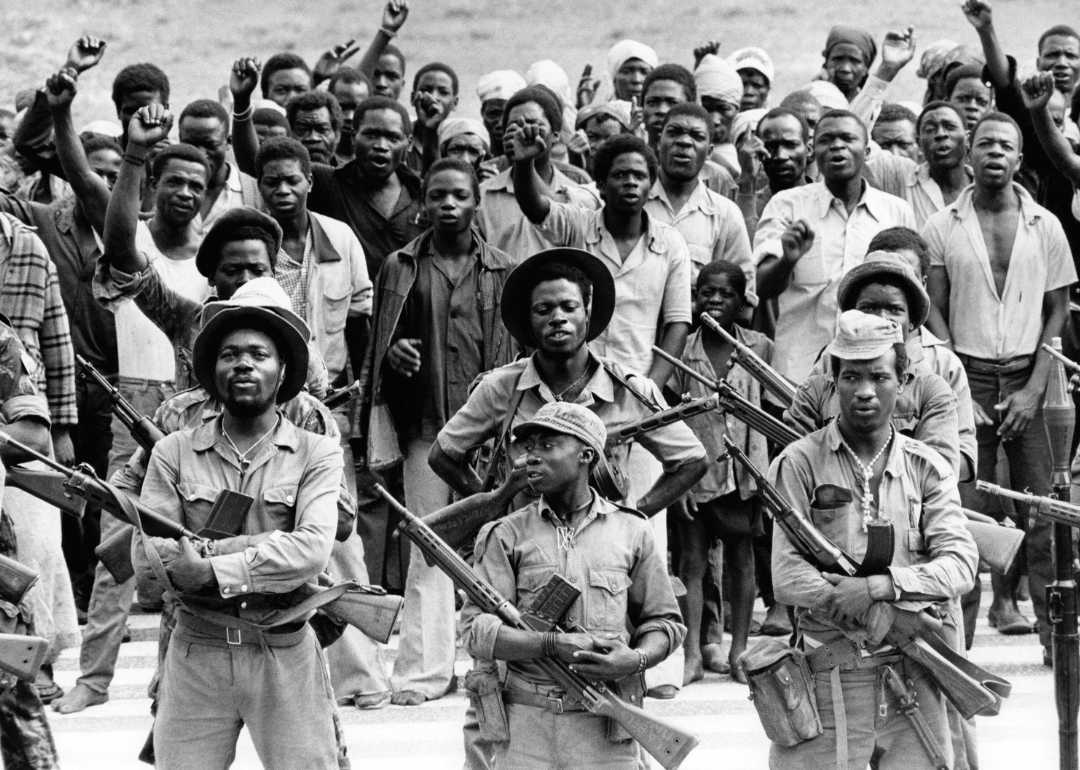
PRESSENS BILD/AFP via Getty Images
1976: People’s Republic of Angola was established with support from Cuba and the Soviet Union
On Nov. 11, 1975, Angola declared its independence from Portugal after nearly 400 years of rule. In December of the following year, the United Nations formally recognized the People’s Republic of Angola. This development followed the Angola crisis of 1974-1975, during which the U.S. and U.S.S.R. competed to influence the impending establishment of a new government. The People’s Movement for the Liberation of Angola, a socialist movement, ultimately won out in an apparent victory for the U.S.S.R.
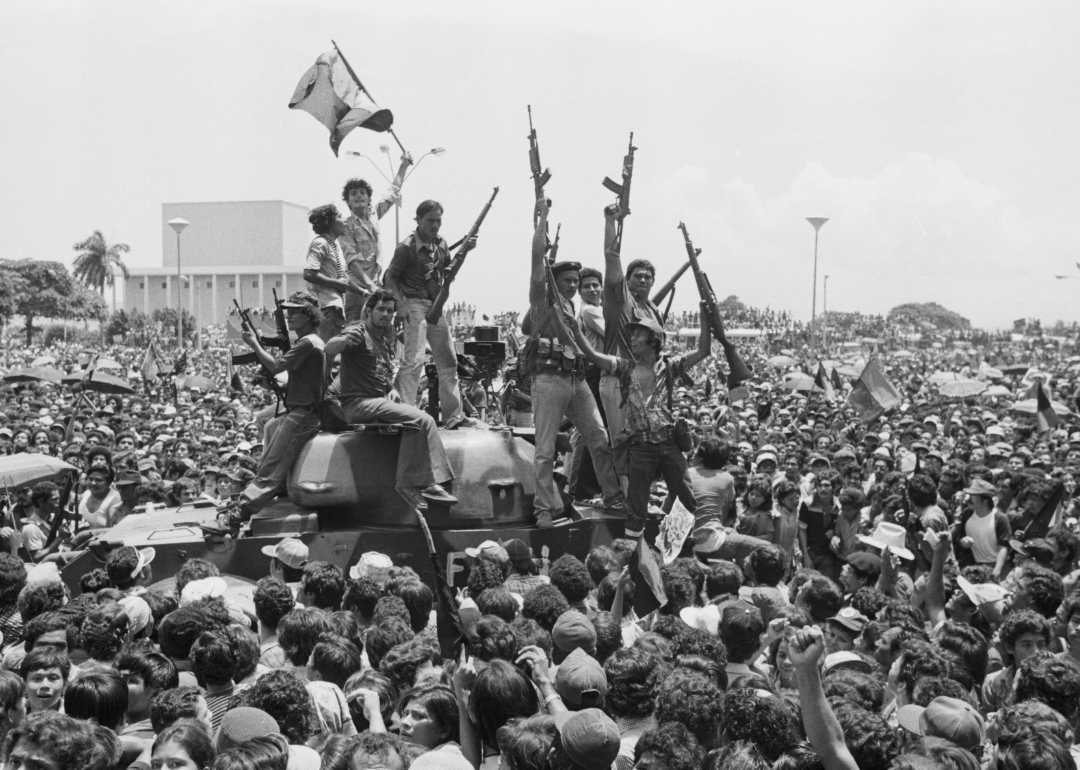
Bettmann // Getty Images
1979: Contras War in Nicaragua begins
In another proxy war amid the Cold War era, the Sandinista National Liberation Front violently overthrew the Somoza family political dynasty in an effort to liberate Nicaragua from dictatorship. The nation served as another battleground for the U.S. and U.S.S.R. as they attempted to influence the outcome through funding the FSLN and the Contras, a counter-revolutionary group, respectively.
You may also like: Sitcom history from the year you were born
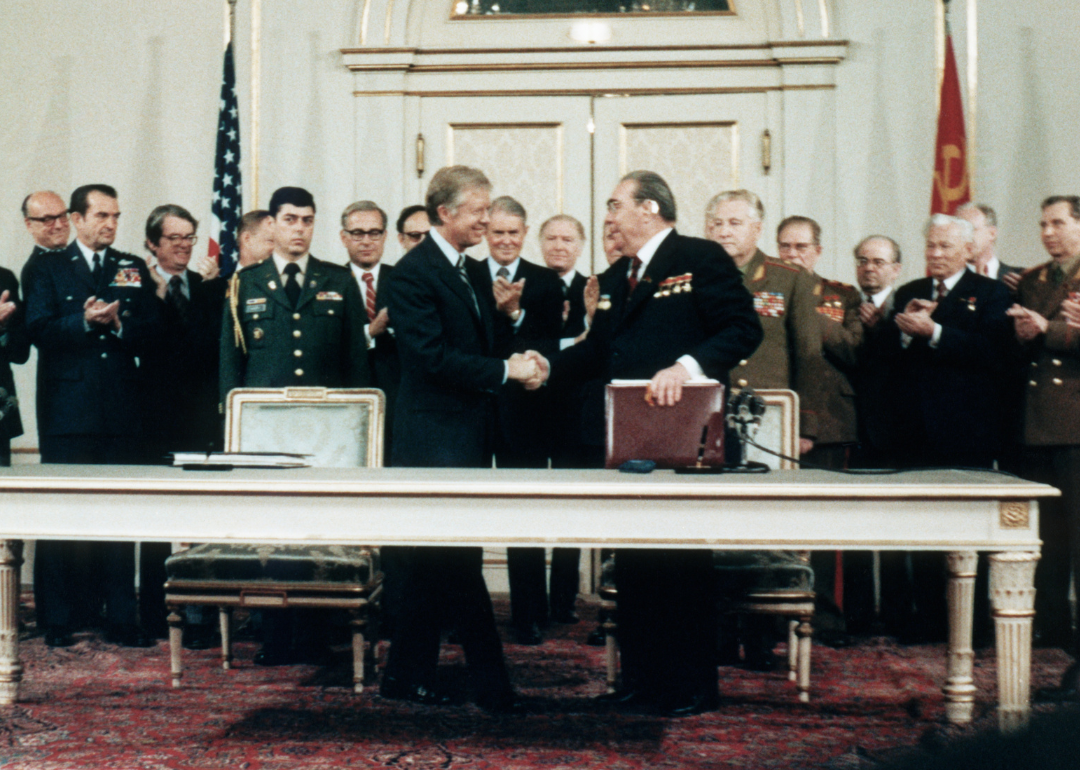
CORBIS/Corbis via Getty Images
1979: SALT II treaty signed; Iranian Hostage Crisis
After seven years of preemptive talks, and in continuation of the SALT I treaty in 1972, the U.S. and U.S.S.R. agreed to reduce the manufacturing of strategic nuclear weapons on June 18, 1979. Months later, on Nov. 4, 1979, Iranian militants detained 66 American citizens from the U.S. embassy in Tehran, holding 52 of them within that building for more than a year. The crisis severely undermined President Jimmy Carter’s foreign policy acumen and set the stage for escalating tensions between the U.S. and Iran.
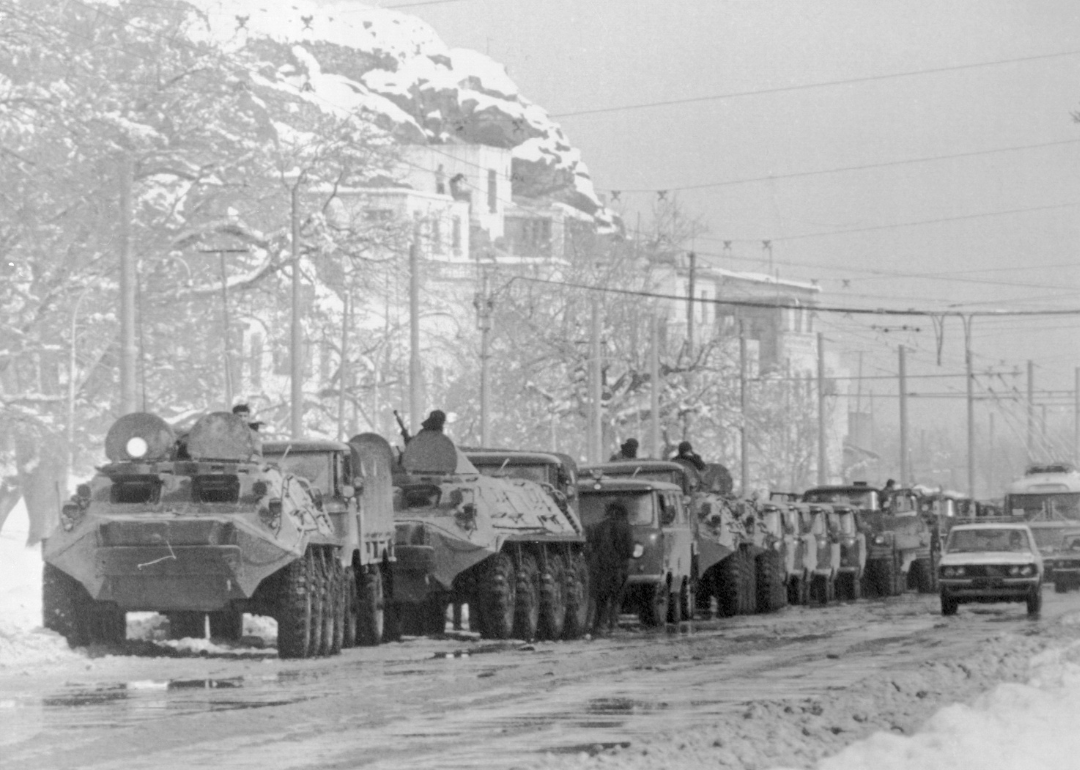
Bettmann // Getty Images
1979: USSR invades Afghanistan
On Dec. 24, 1979, the U.S.S.R. sent 30,000 Soviet troops into Afghanistan to help the Communist government resist U.S.-backed anti-Communist forces amid the Afghan War. The conflict itself ended in 1989 in a stalemate, but the invasion nonetheless bore out more severe consequences for the Soviet Union, as it suffered crippling financial loss and a degraded position in world politics that preempted its ultimate fall.
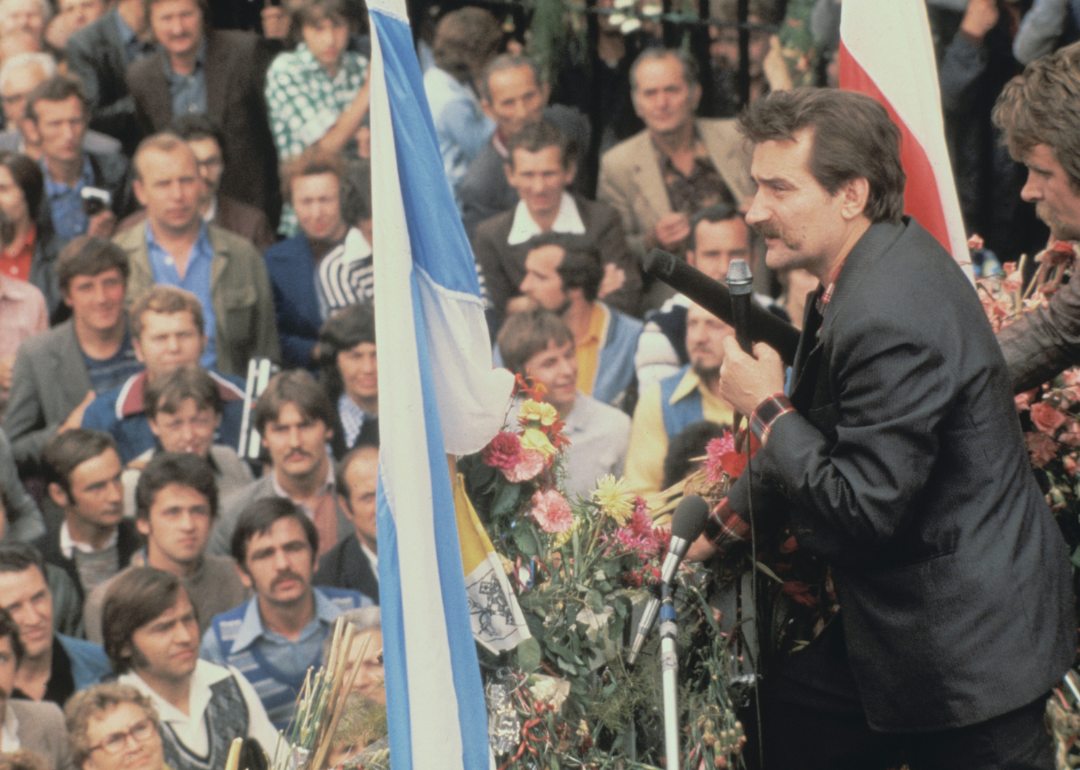
Bettmann // Getty Images
1979: USSR invades Afghanistan
On Dec. 24, 1979, the U.S.S.R. sent 30,000 Soviet troops into Afghanistan to help the Communist government resist U.S.-backed anti-Communist forces amid the Afghan War. The conflict itself ended in 1989 in a stalemate, but the invasion nonetheless bore out more severe consequences for the Soviet Union, as it suffered crippling financial loss and a degraded position in world politics that preempted its ultimate fall.
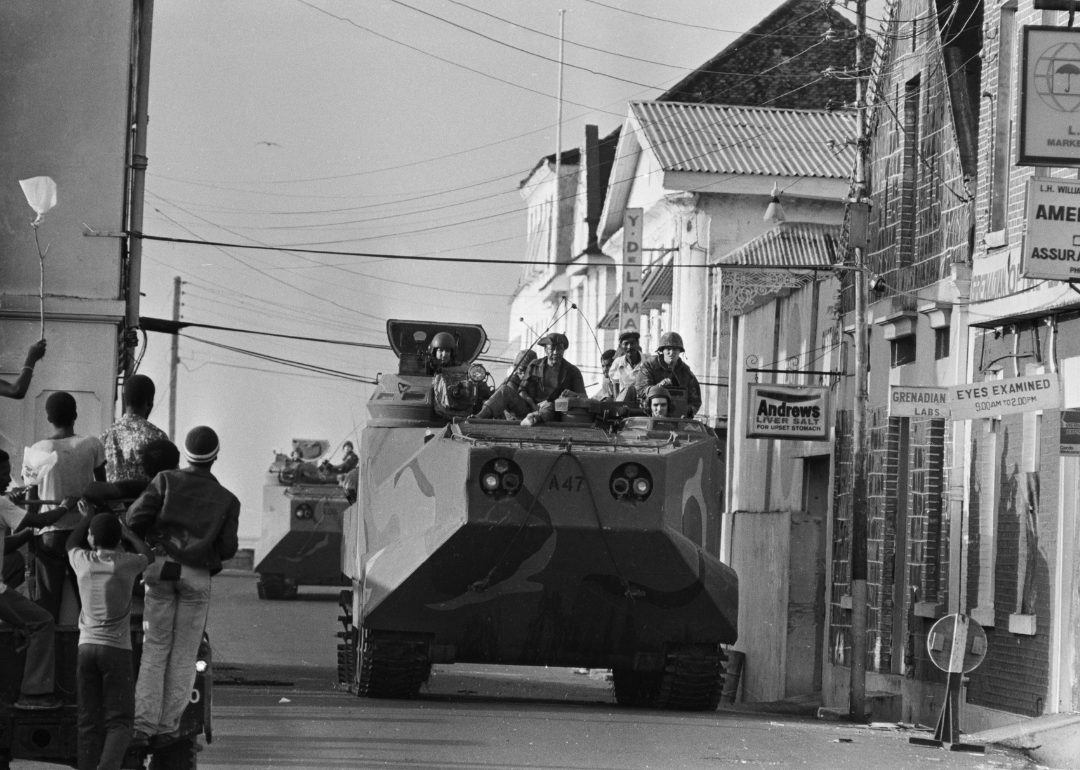
Bettmann // Getty Images
1980: Solidarity Movement starts in Polish shipyards
On Aug. 14, 1980, Lech Walesa and his shipyard colleagues formed the first independent labor union in a Soviet country. The Polish government failed to permanently suppress the anti-Communist movement, which eventually attracted over 9 million members. The rapid formation and growth of the group echoed growing anti-Communist sentiments worldwide. In addition to receiving the Nobel Peace Prize, Walesa became the first democratically elected president of Poland since 1926 and the first to win a popular majority when he ascended to office in 1990.
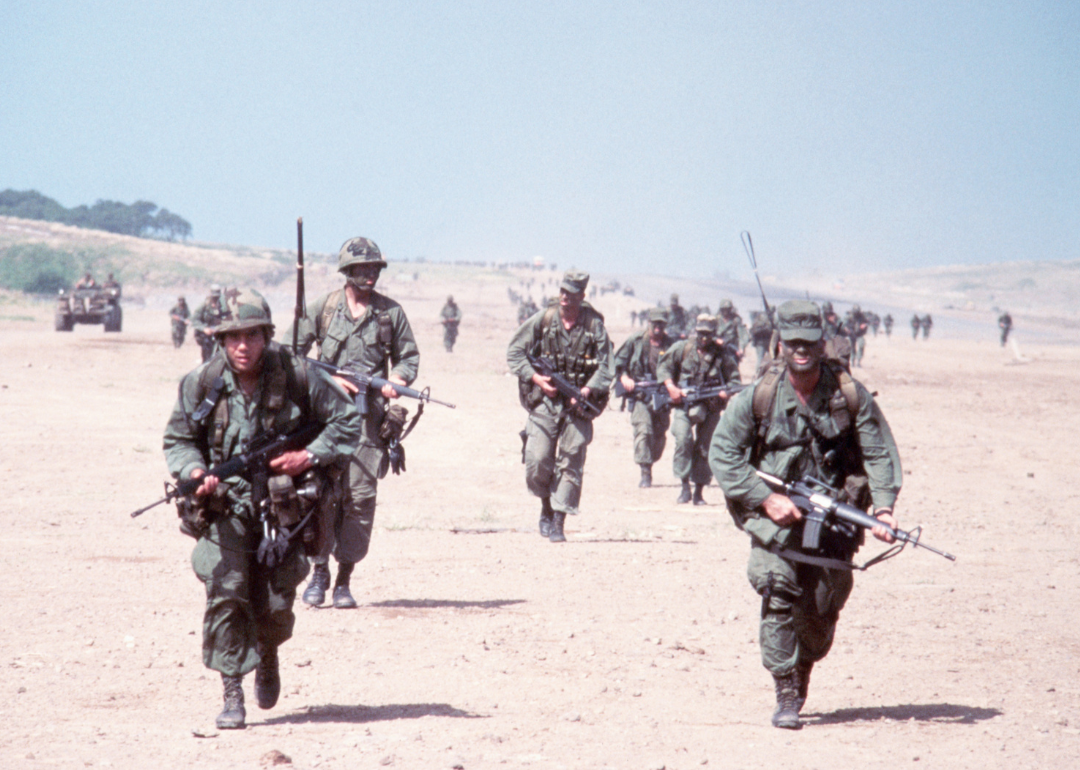
Bettman // Getty Images
1983: US troops invade Grenada, overthrow regime
By order of President Ronald Reagan, U.S. troops invaded the Soviet- and Cuba-aided country of Grenada on Oct. 25, 1983, under the pretense of protecting U.S. students following the poorly received response to the Iranian Hostage Crisis. After four days, the U.S. established military occupation of the country.
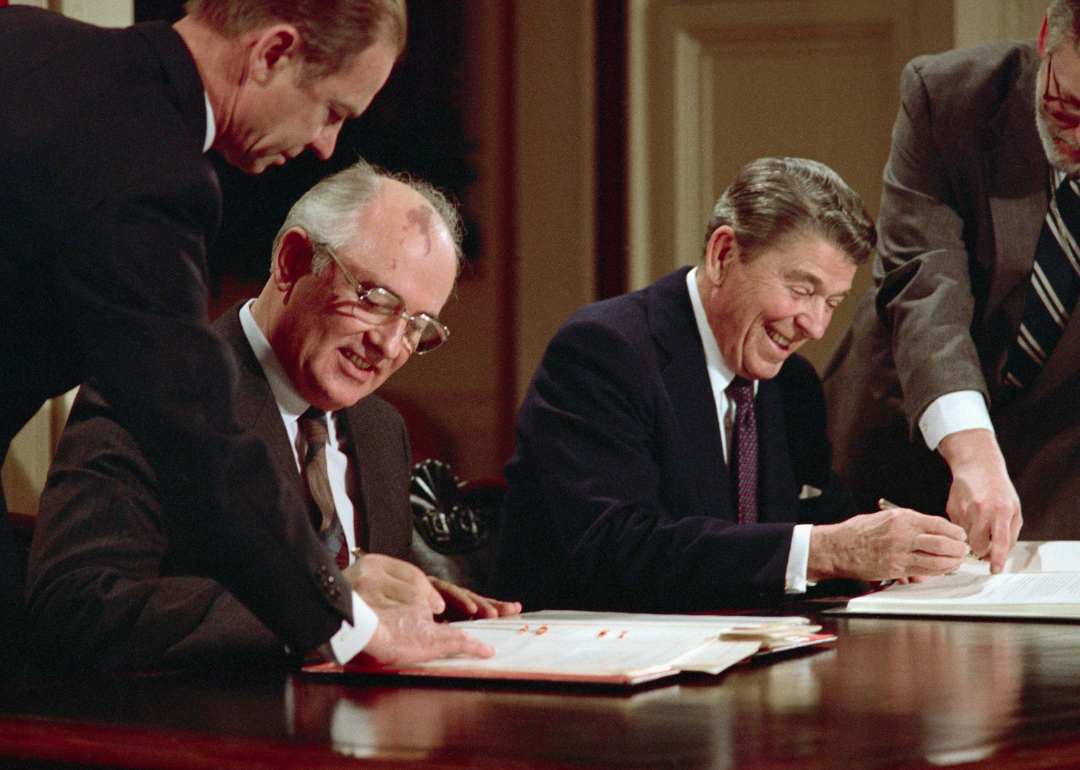
Bettmann // Getty Images
1985: Mikhail Gorbachev becomes leader of the Soviet Union
Following the deaths of Yuri Andropov and Konstantin Chernenko in rapid succession between 1984 and 1985, Mikhail Gorbachev took office as the leader of the Soviet Union on March 11, 1985. Through his propensity for cultivating friendlier international relationships, Gorbachev is credited with helping end the Cold War, for which he earned the 1990 Nobel Peace Prize.
You may also like: How much the typical home cost in your state in 1950
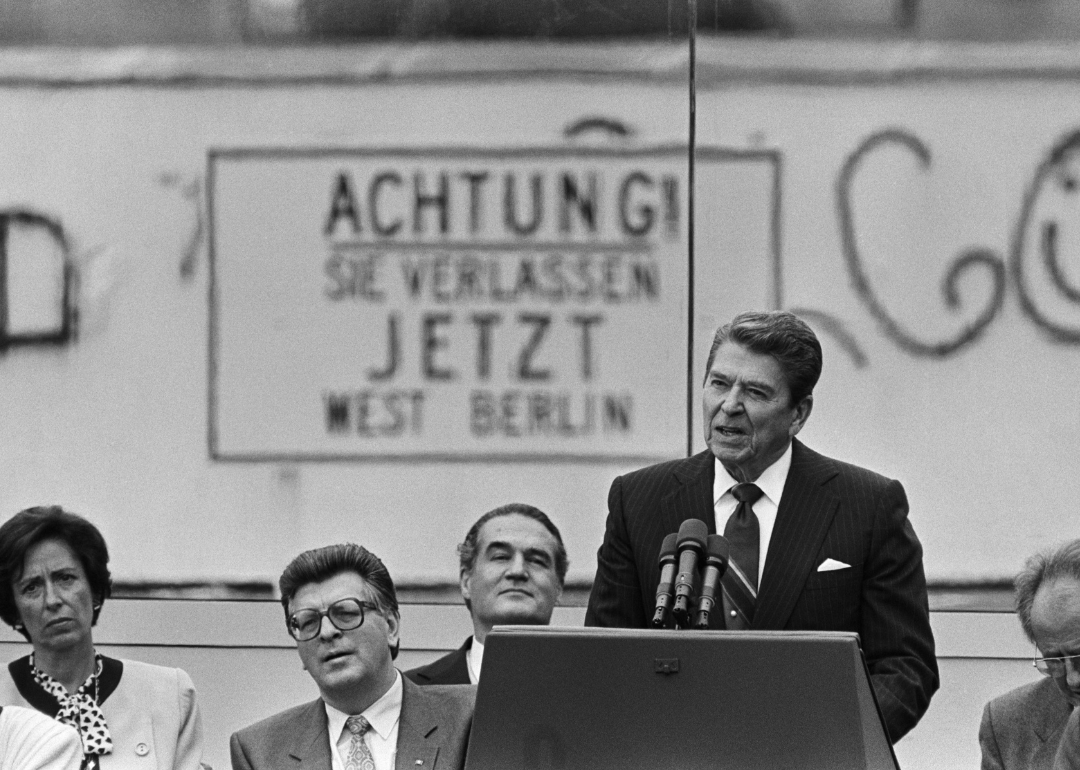
Bettmann // Getty Images
1986-1987: US and USSR agree to remove intermediate, medium- and short-range nukes from Europe
On Dec. 8, 1987, President Reagan and Soviet leader Gorbachev formally agreed to remove all intermediate and short-range missiles and launchers from Europe when they signed the Intermediate-Range Nuclear Forces Treaty. Over the next three years, the two superpowers dismantled a total of 2,692 missiles.
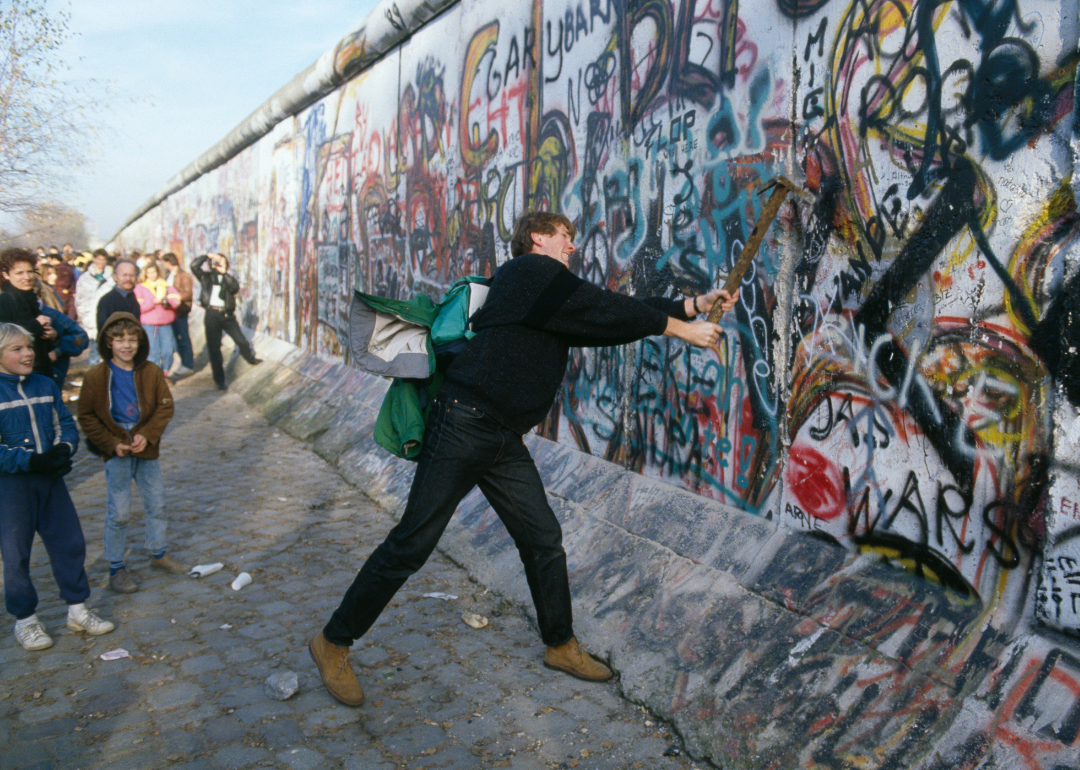
Jacques Langevin/Sygma/Sygma via Getty Images
1987: Reagan delivers “Berlin Wall Speech” at Brandenburg Gate
Amid lessening tensions between the U.S. and U.S.S.R., President Reagan traveled to the Brandenburg Gate in Berlin, an ongoing symbol of Soviet oppression, to deliver a speech urging peace. In perhaps the most famous words spoken during his presidency, Reagan said, “Mr. Gorbachev, tear down this wall!”
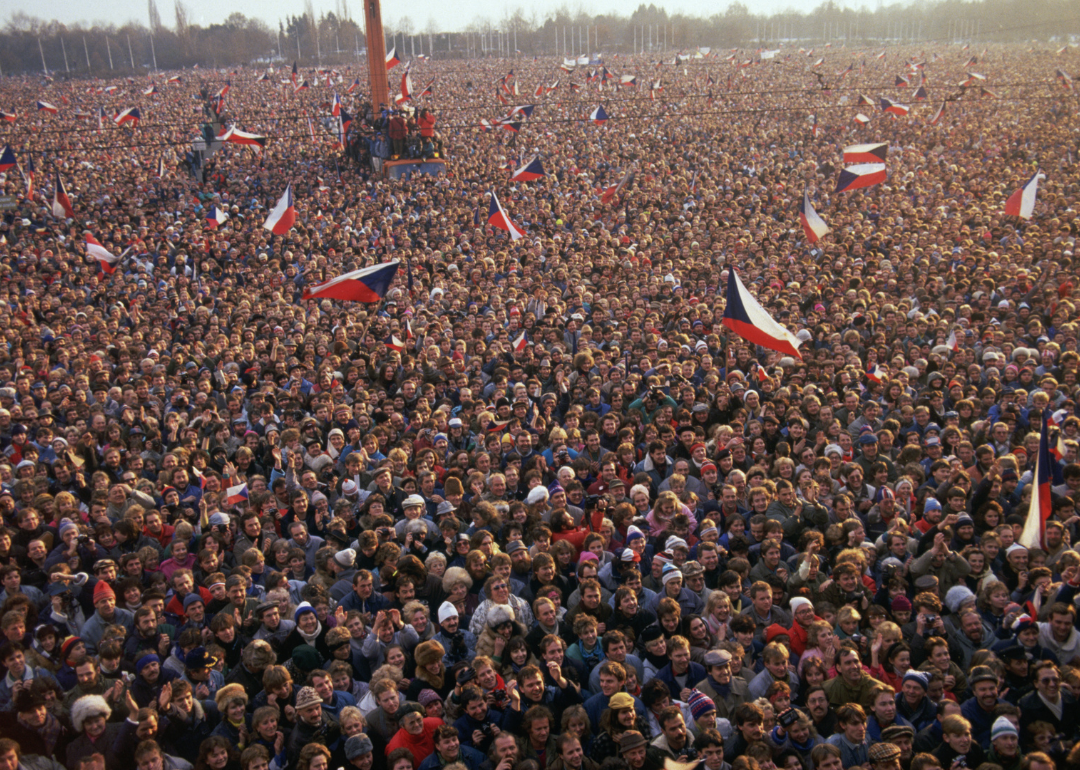
Jacques Langevin/Sygma/Sygma via Getty Images
1989: Soviet troops withdraw from Afghanistan; fall of the Berlin Wall
Following a decade of war and the loss of 15,000 Soviet soldiers, the U.S.S.R. withdrew from Afghanistan in a stalemate on Feb. 15, 1989. Meanwhile, the East German Communist government was ousted by protestors, leaving the Soviets with one less foothold in Europe. On Nov. 9, 1989, the East German government created openings in the Berlin Wall, effectively removing the political and physical barrier between the countries.
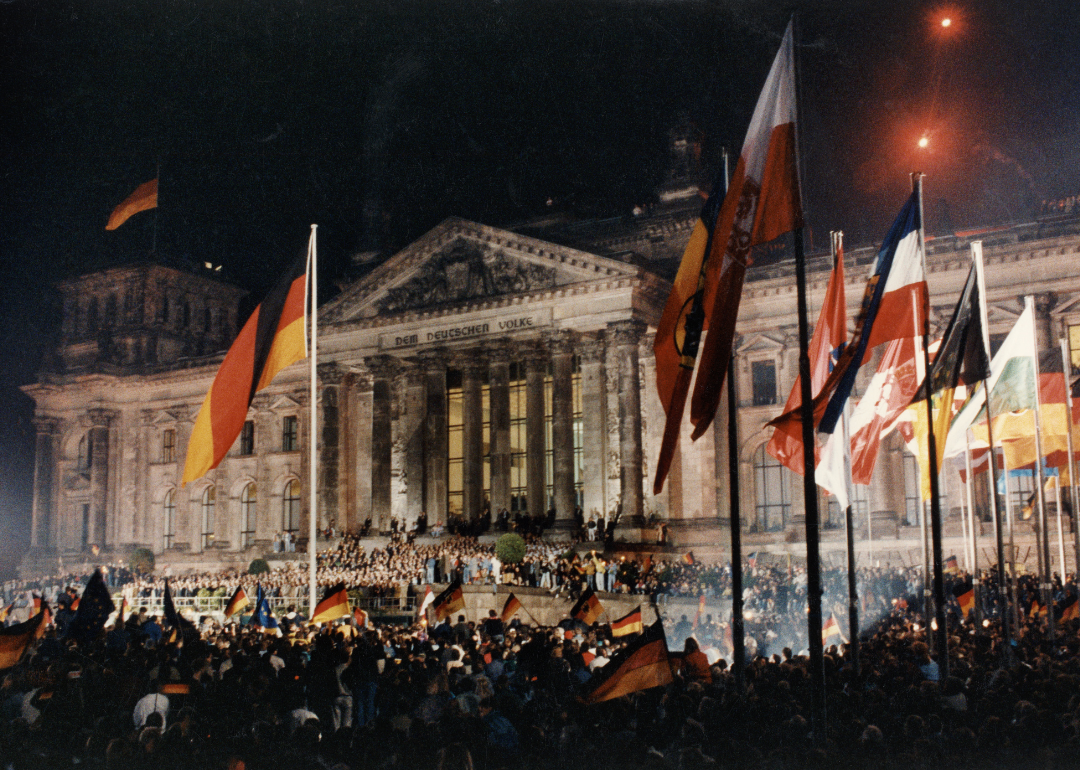
Bodig/ullstein bild via Getty Images
1989: Communist governments in Czechoslovakia, Bulgaria, and Romania crumble
In a mass wave of democratization across Europe, most Communist states fell during the revolutions of 1989 including Czechoslovakia, Bulgaria, and Romania. Anti-communist sentiments persisted for years afterward, and many countries followed suit in dismantling their communist regimes.
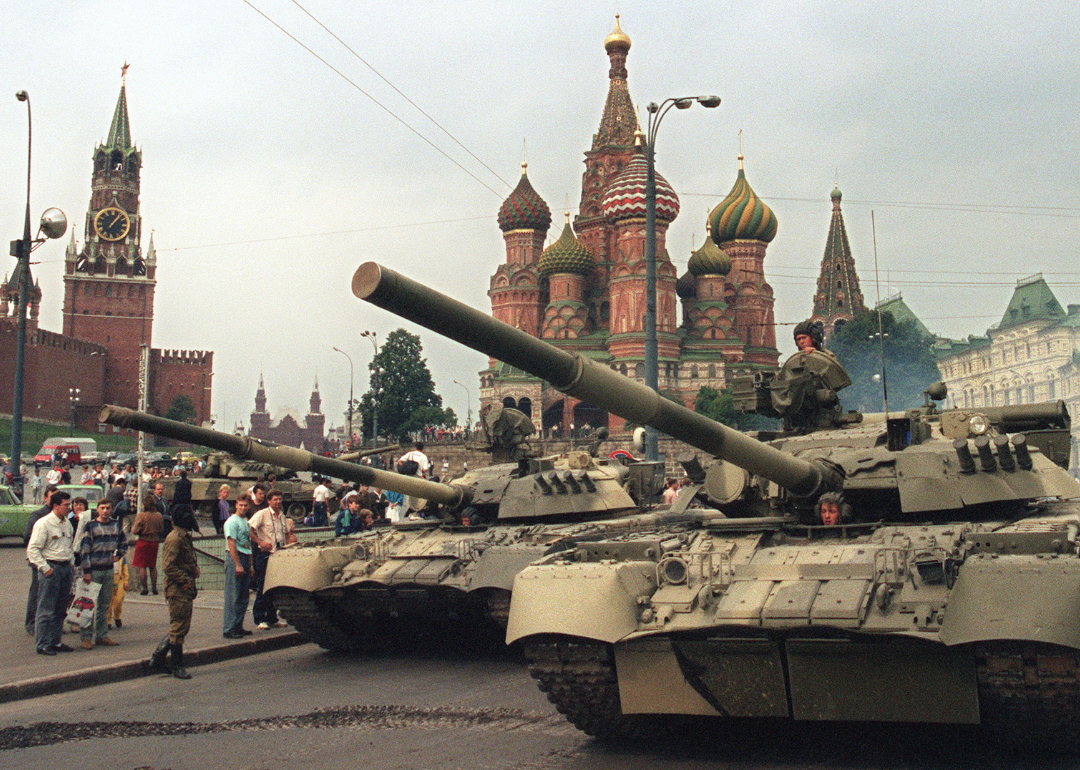
DIMA TANIN/AFP via Getty Images
1990: Reunification of Germany
The reunification of Germany was a process that spanned two years following the fall of the Berlin Wall. On Oct. 3, 1990, the two German territories reunited to form the German Democratic Republic. Then, on March 15, 1991, leaders from the four occupying countries—the United Kingdom, France, the Soviet Union, and the United States—agreed to a treaty re-establishing the territories as a sovereign nation, or present-day Germany.
You may also like: History of rock ‘n’ roll


